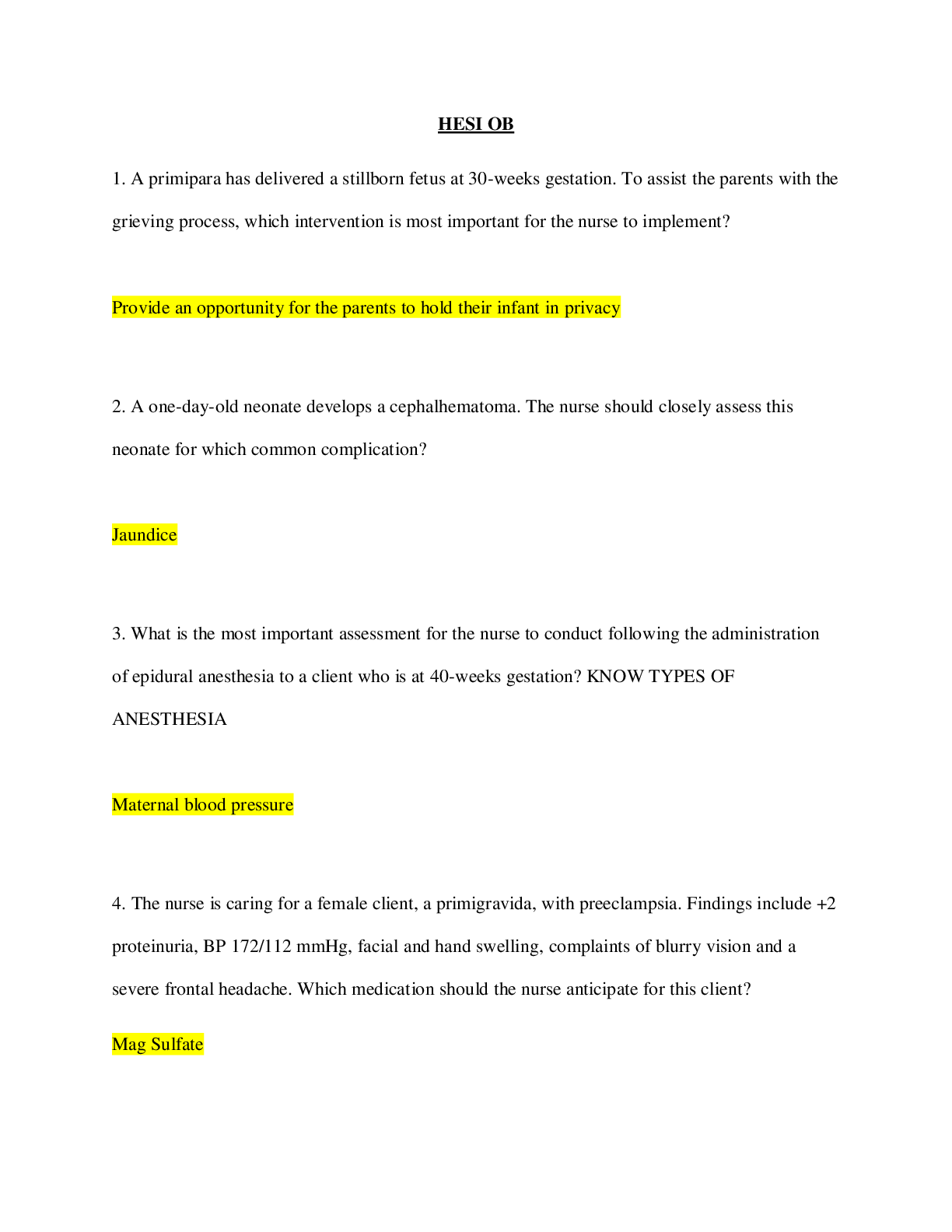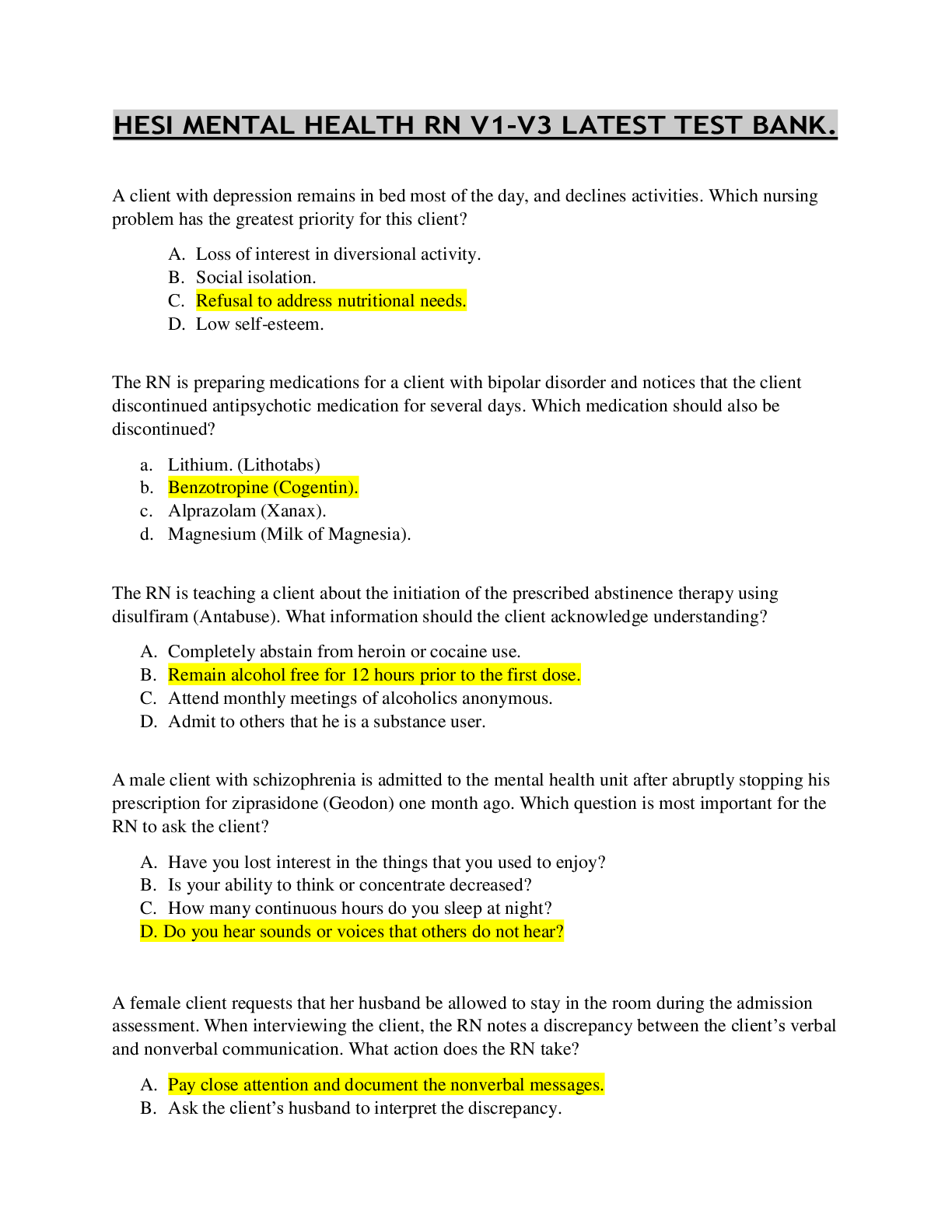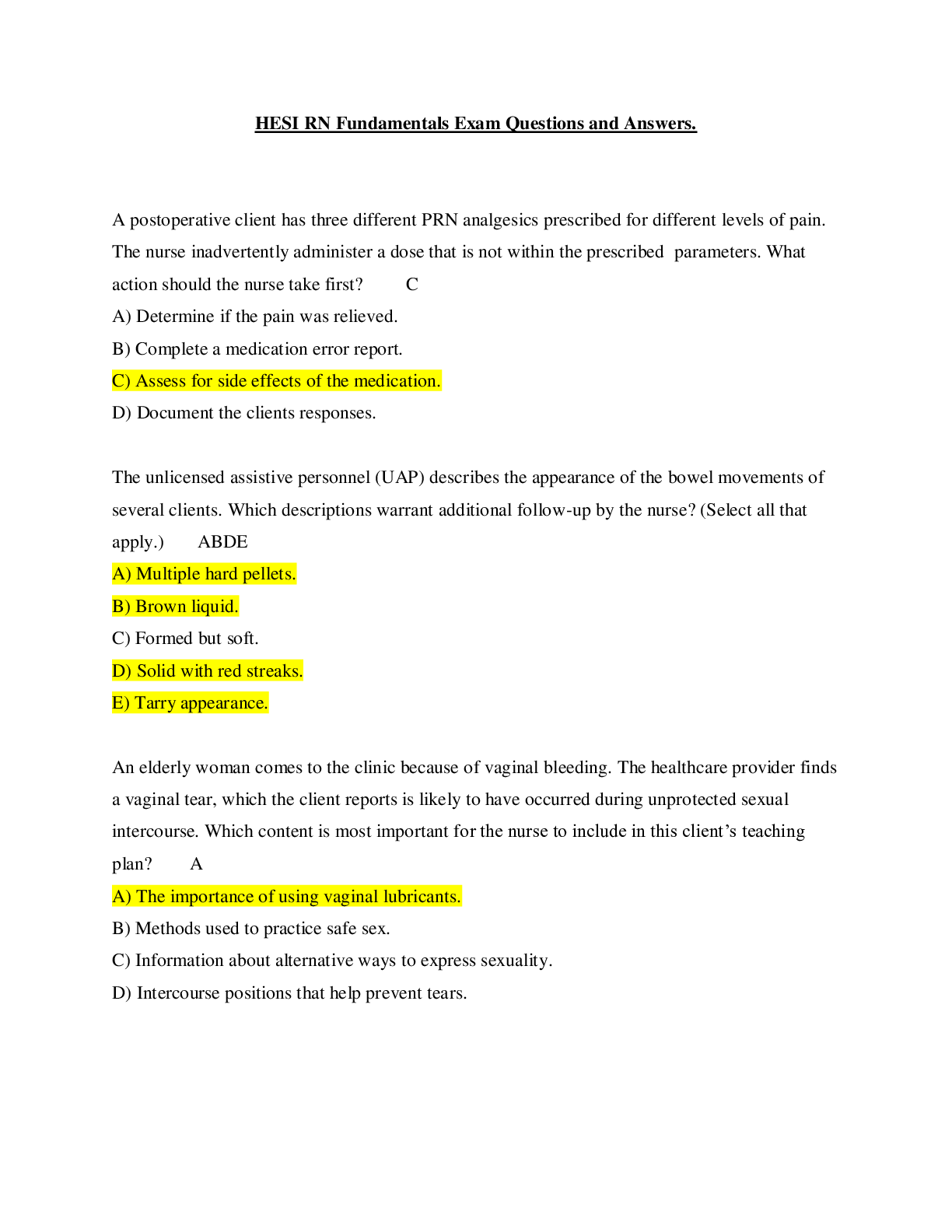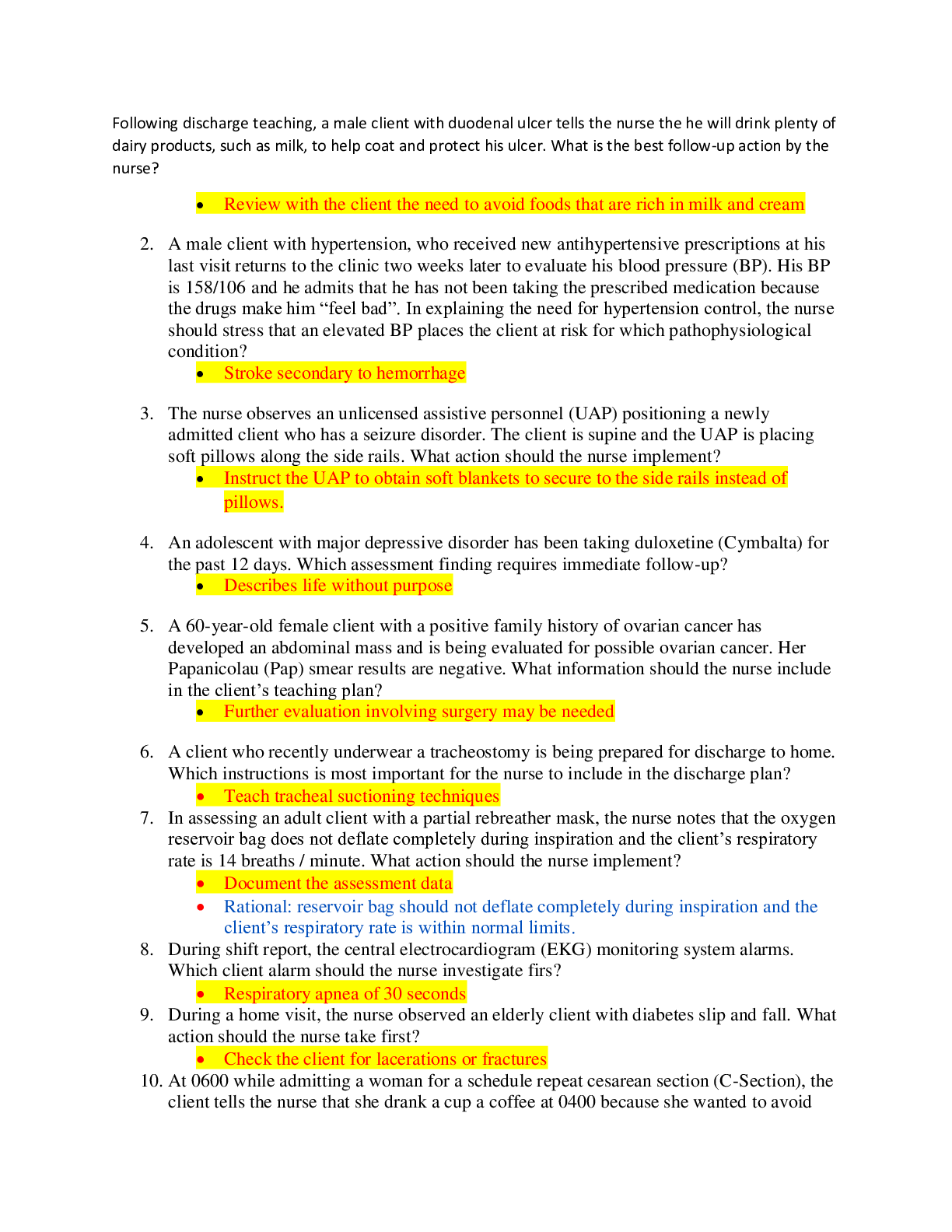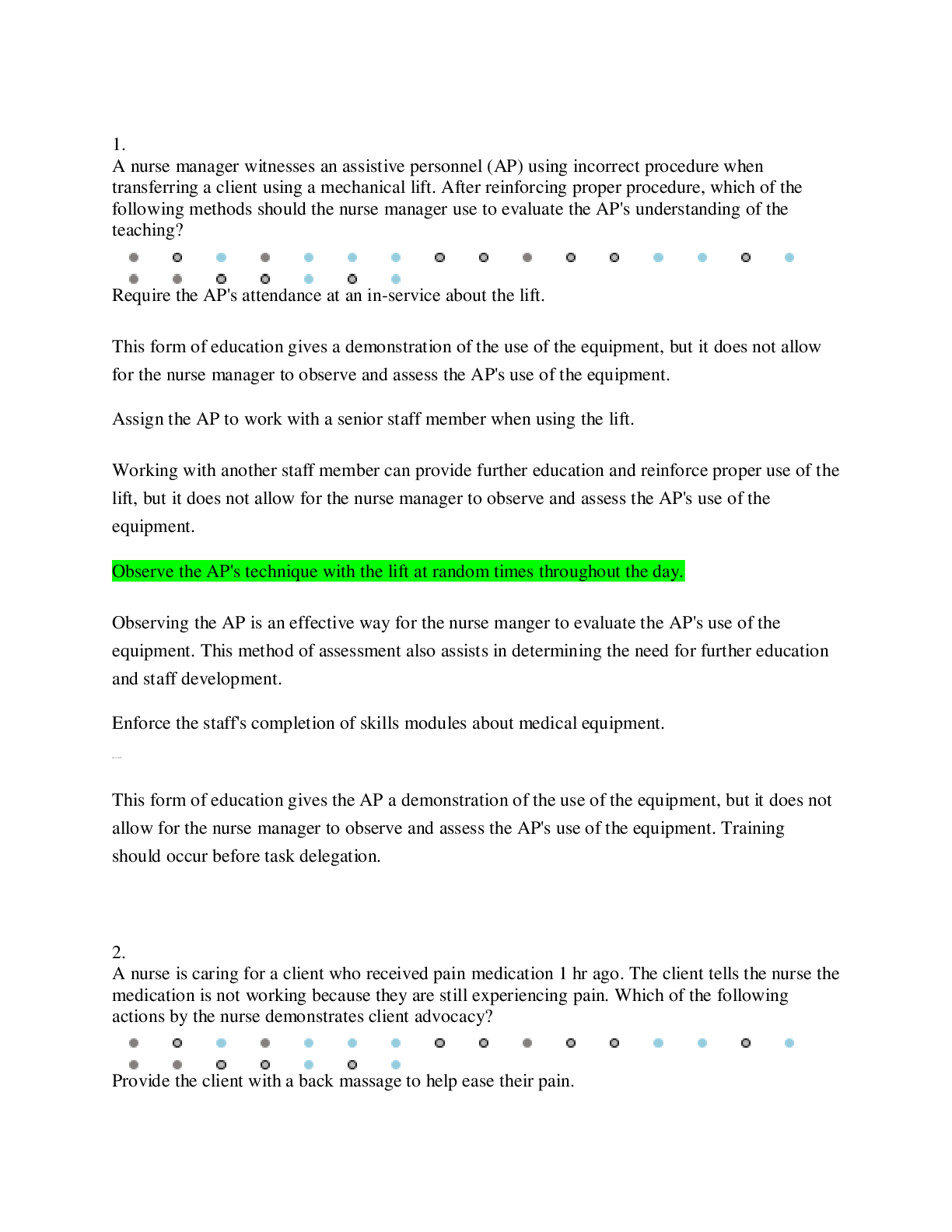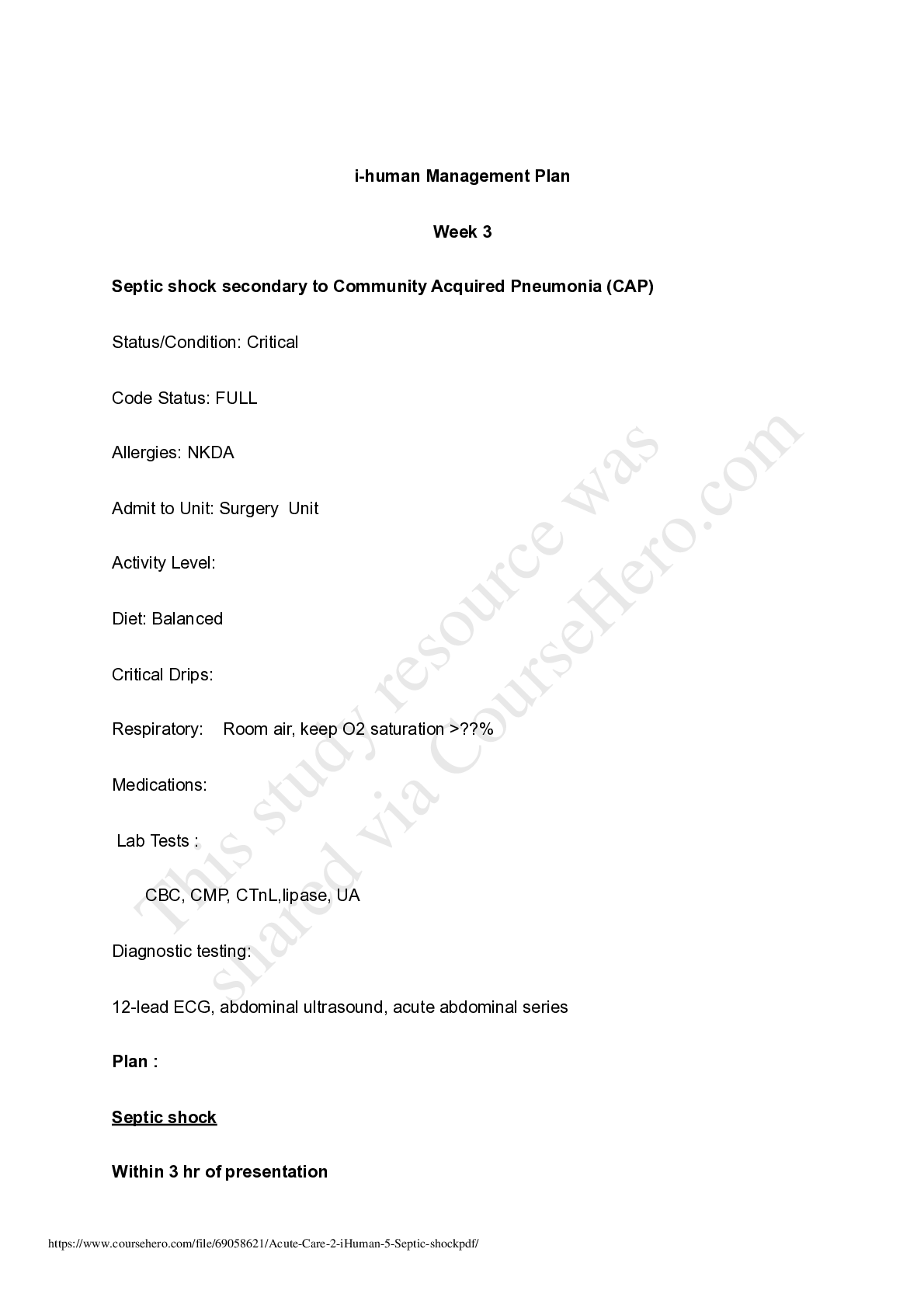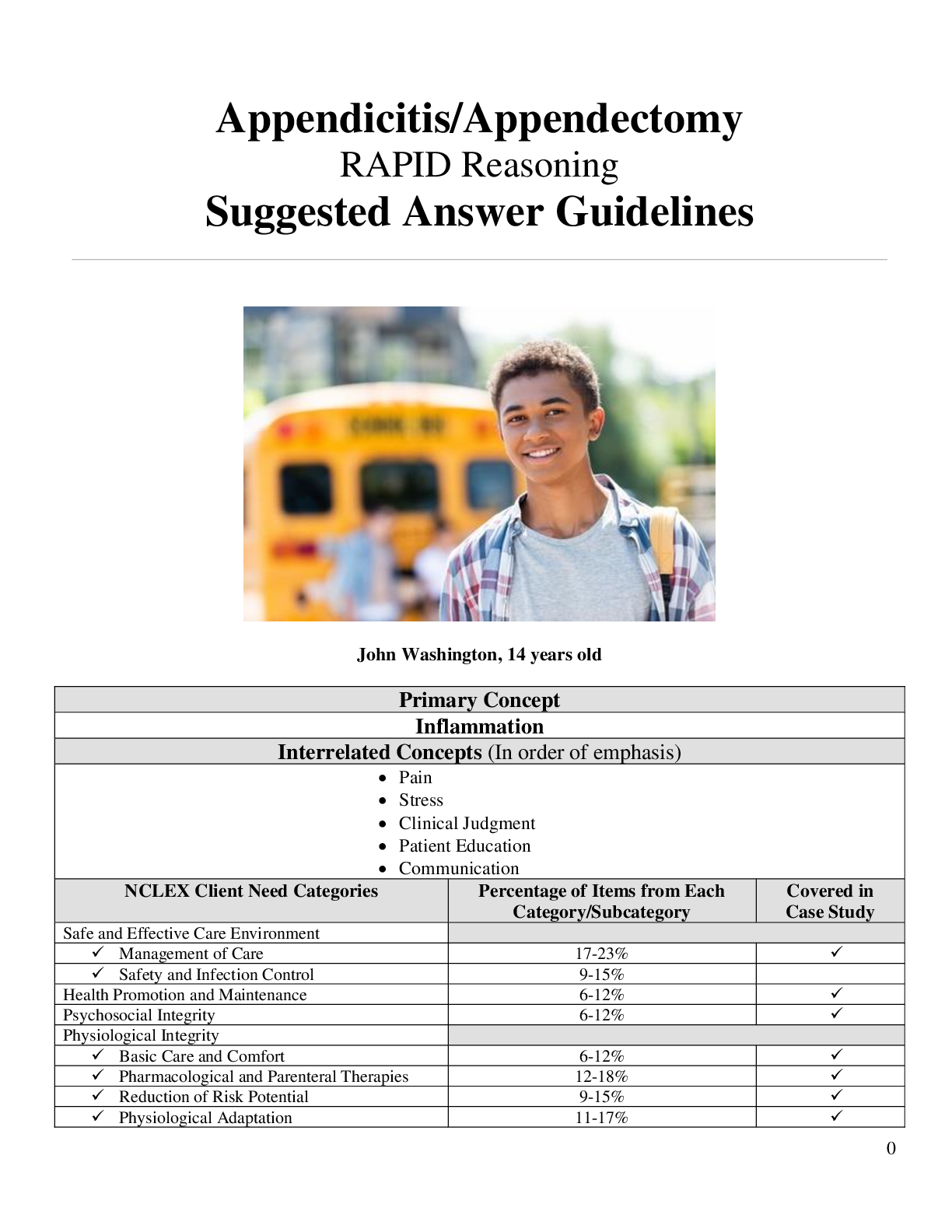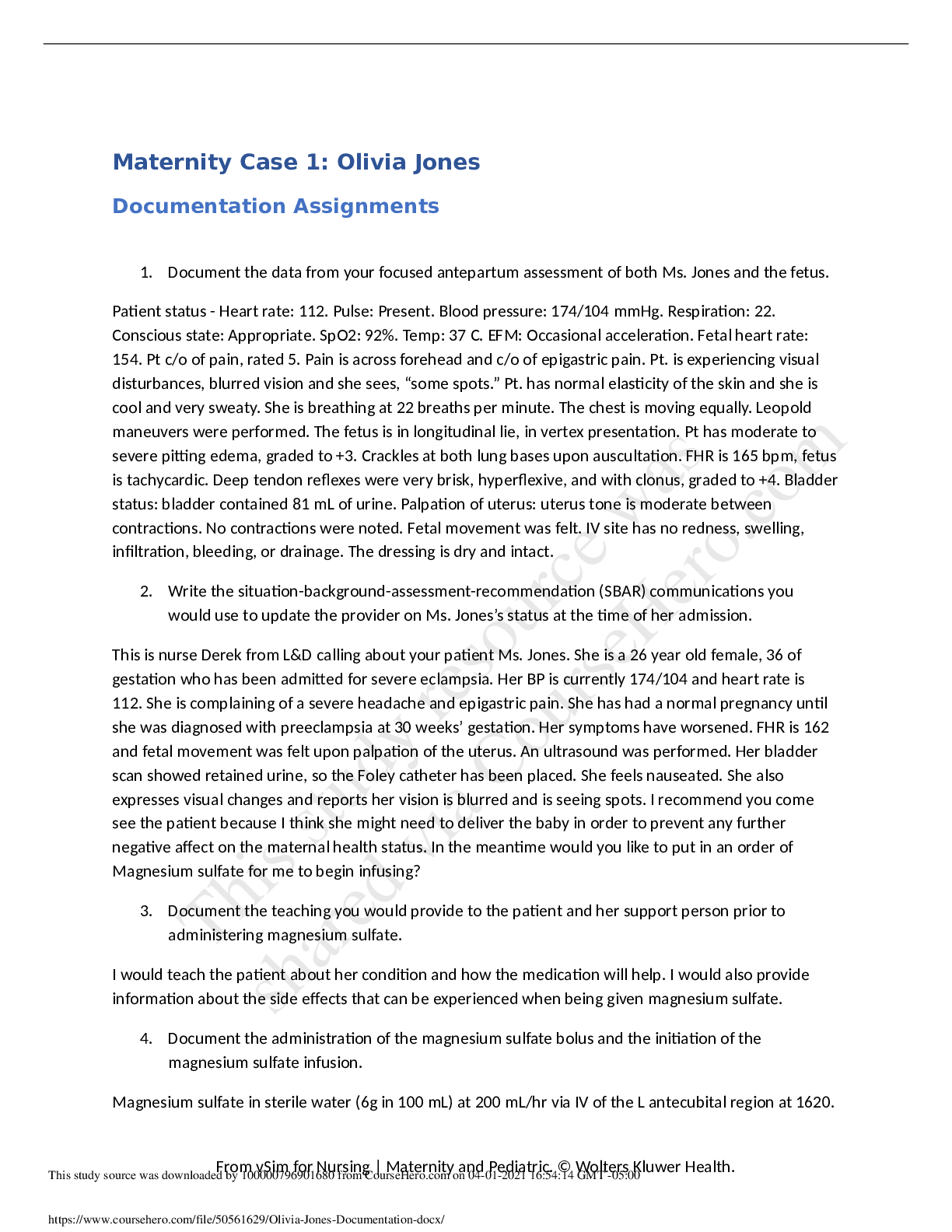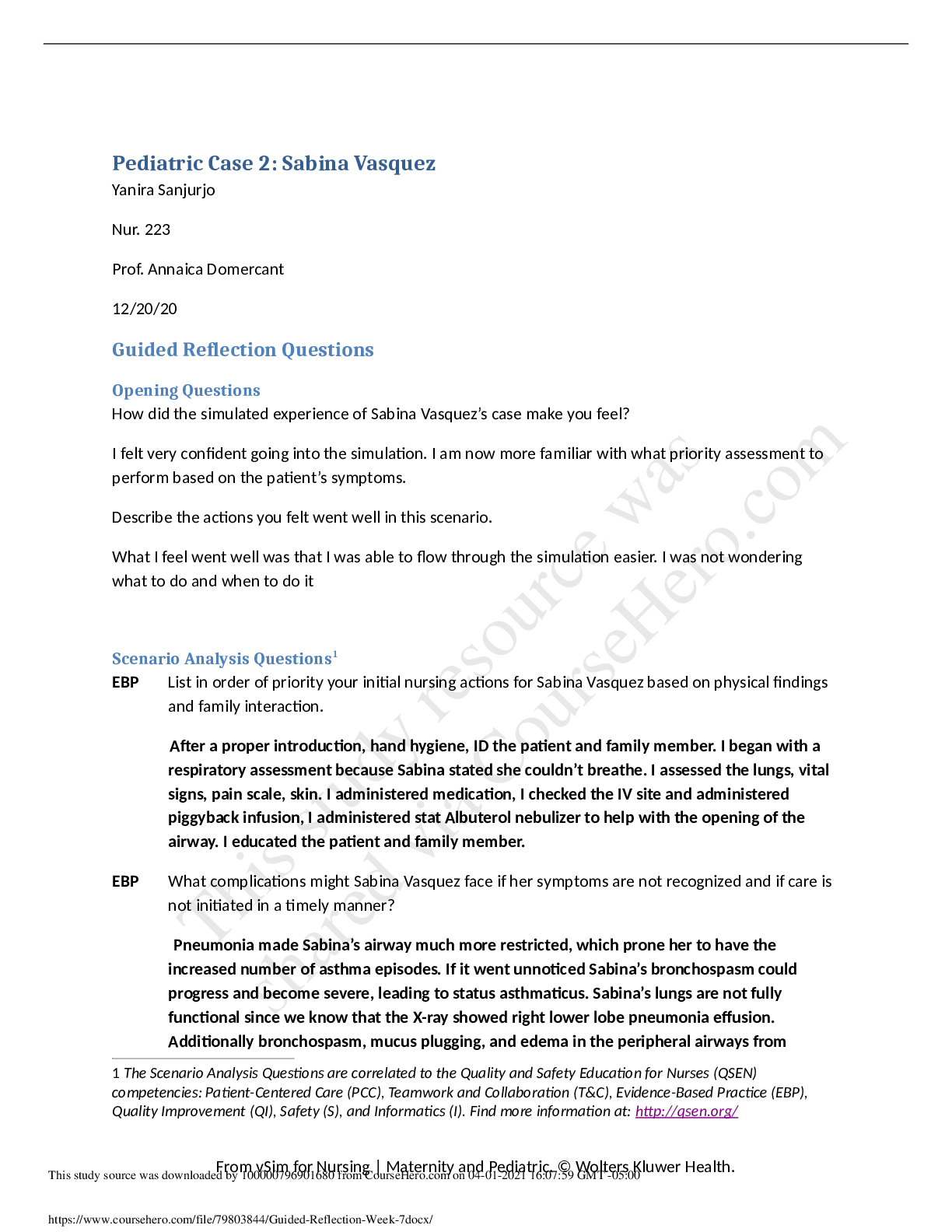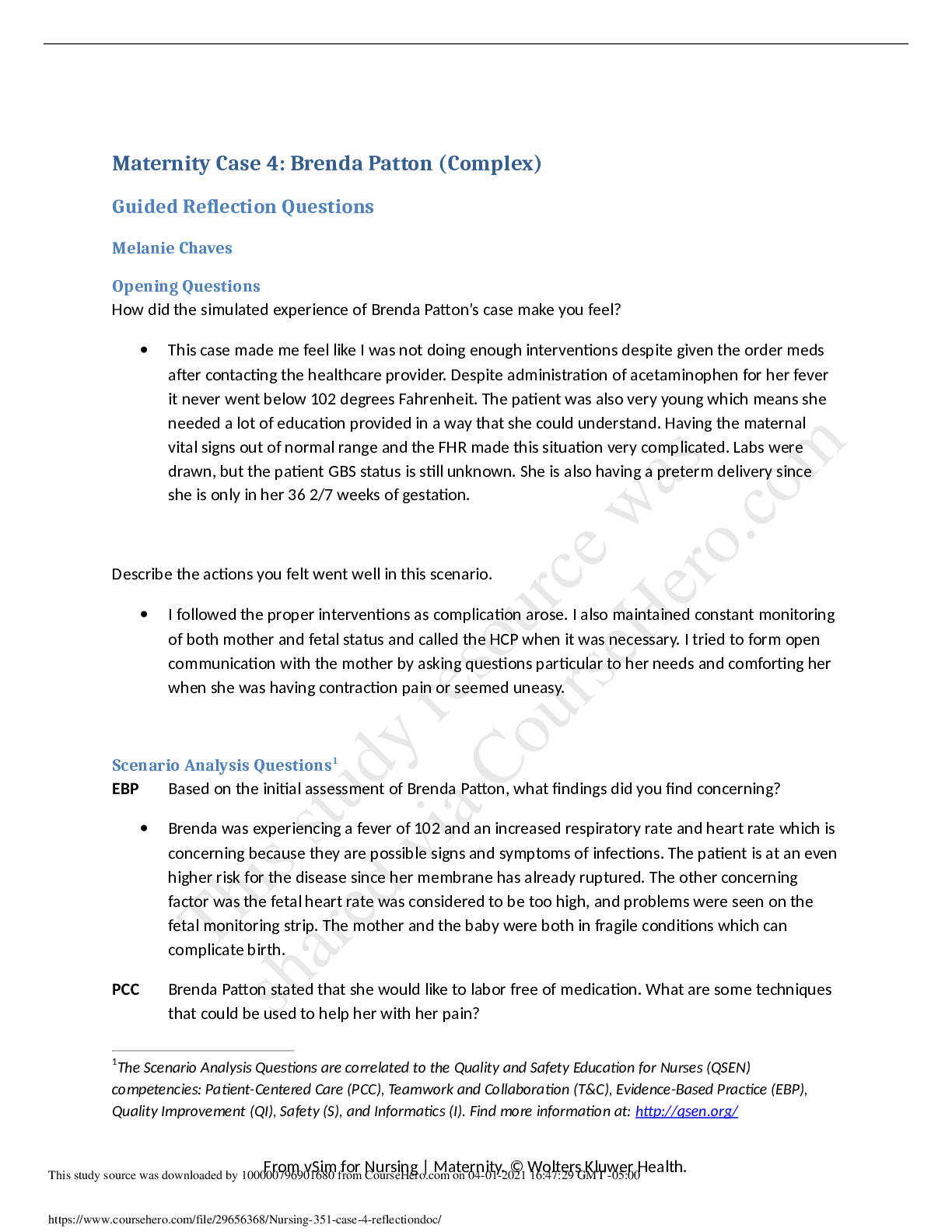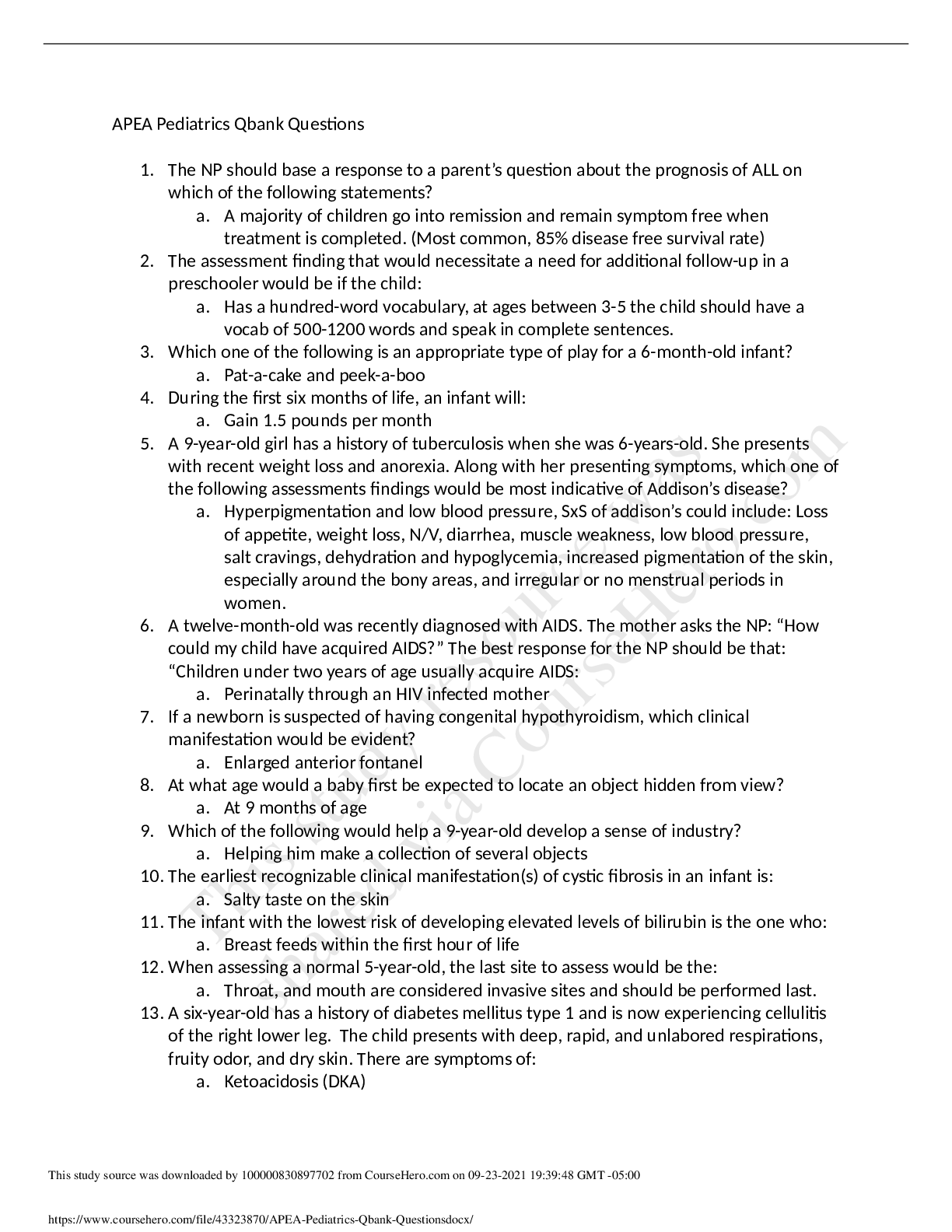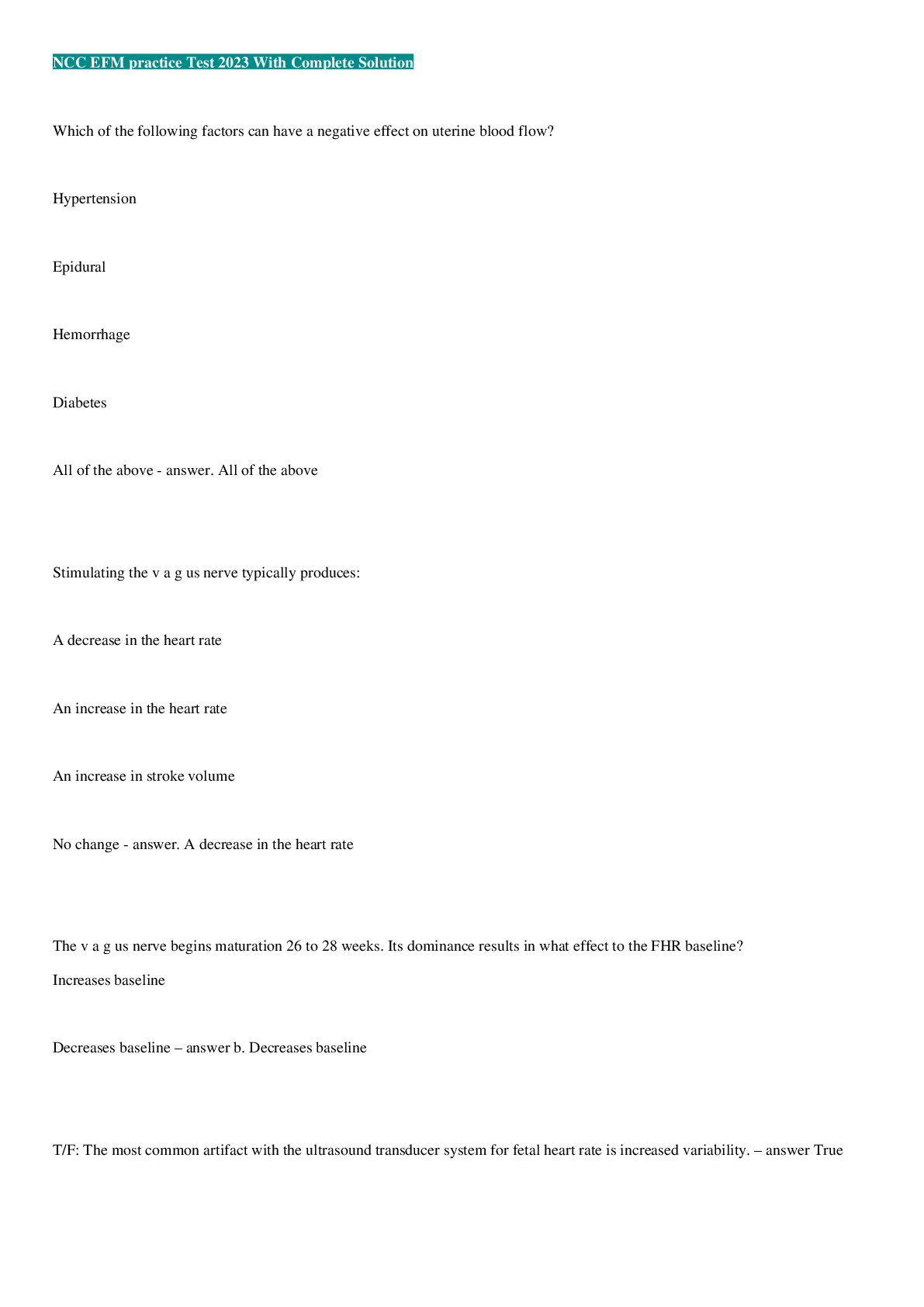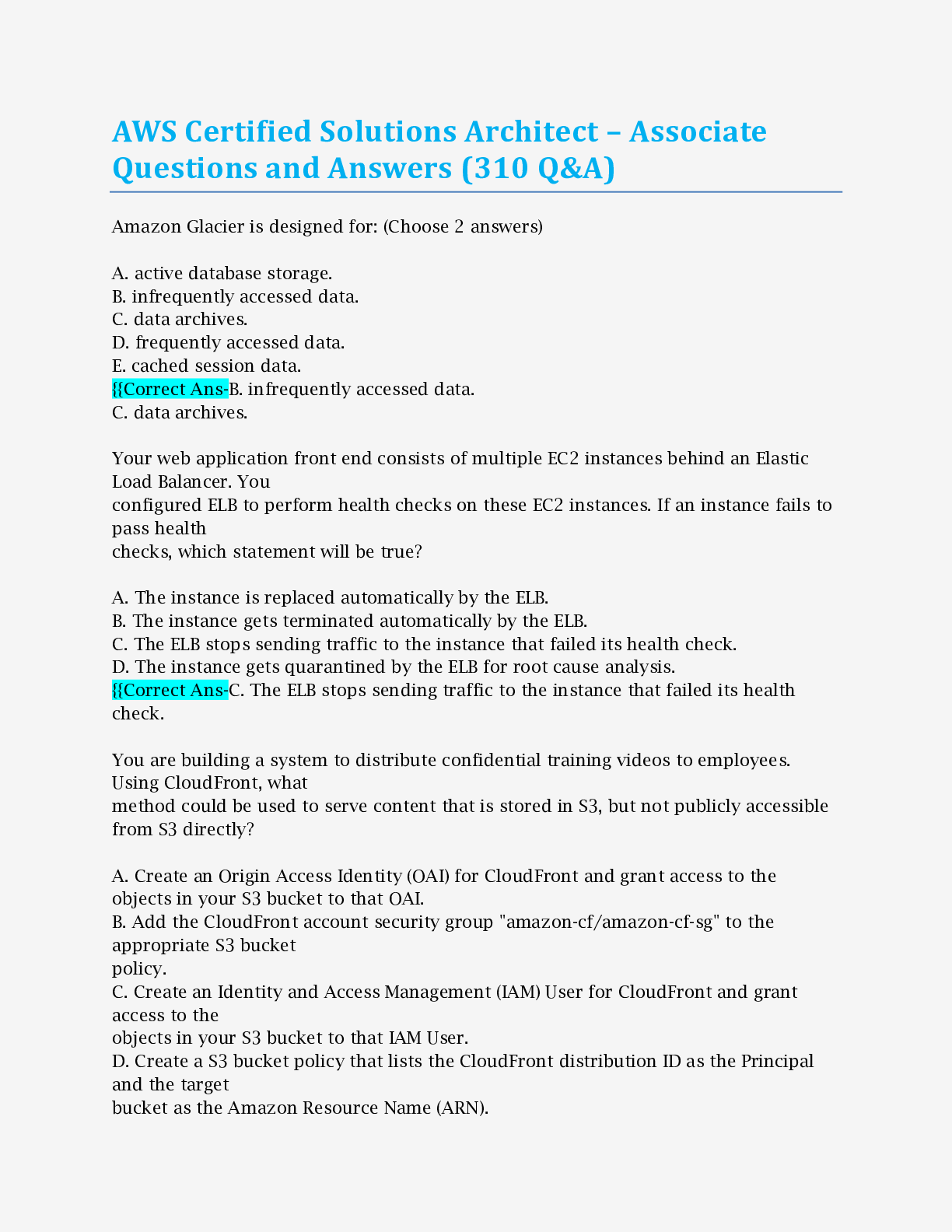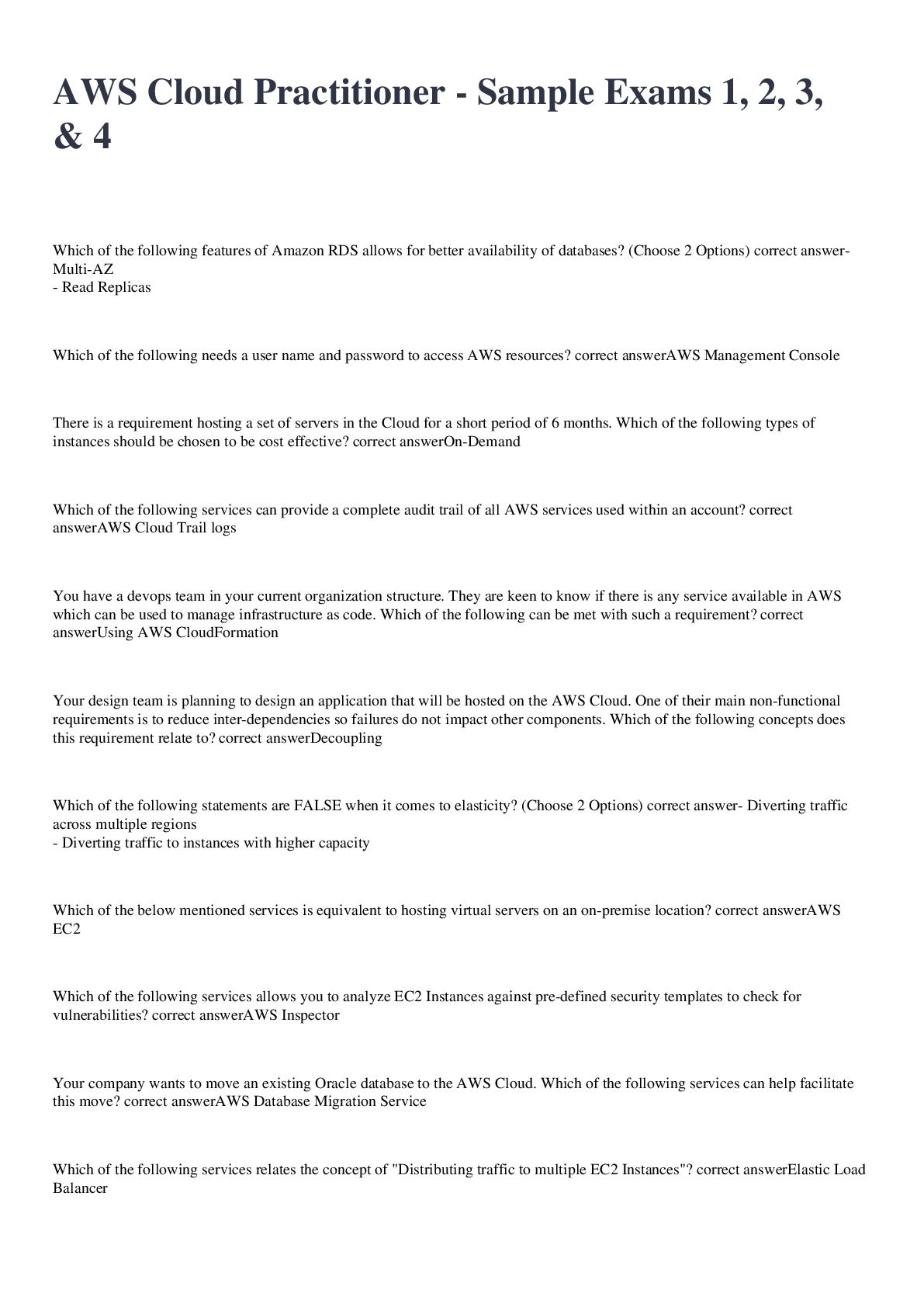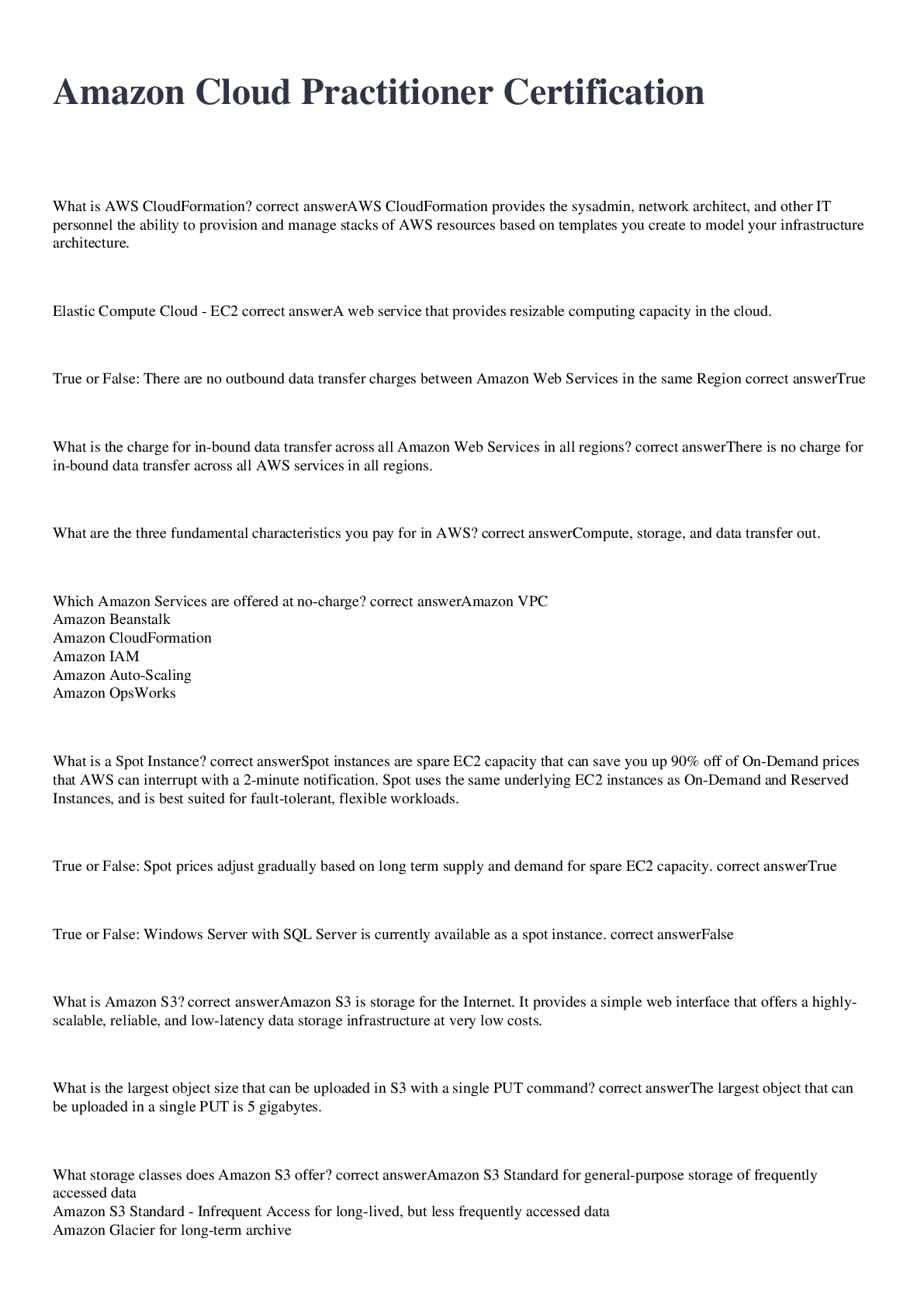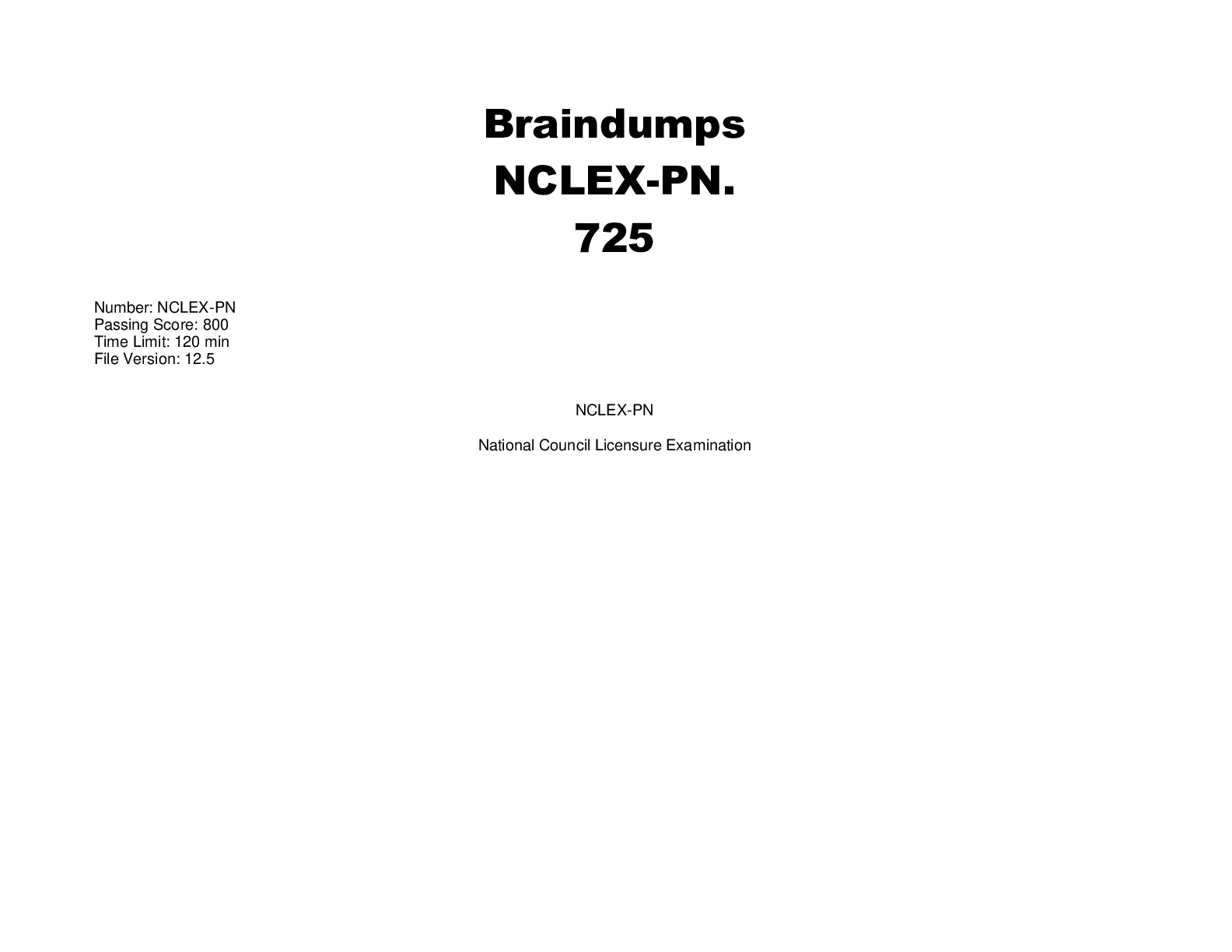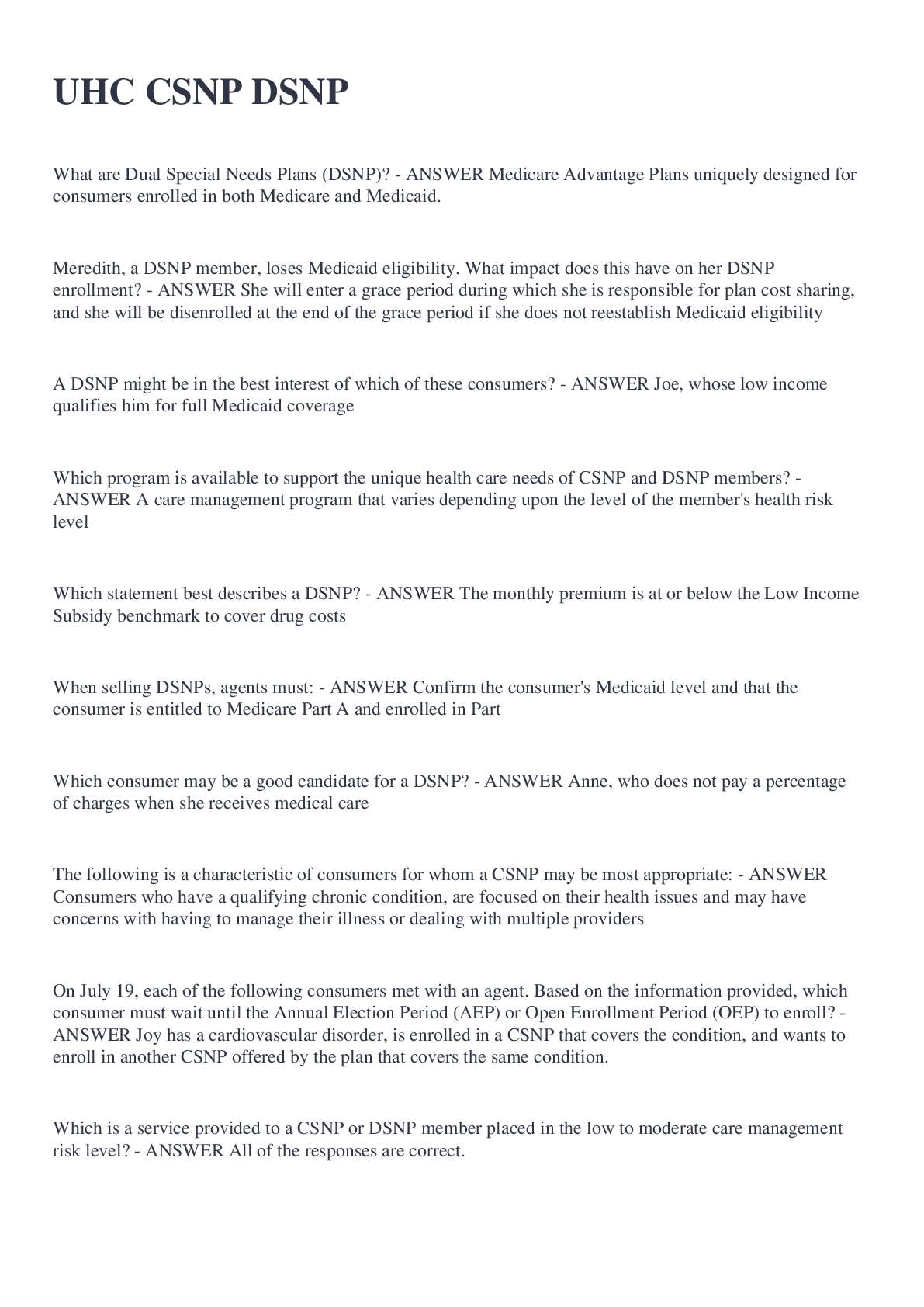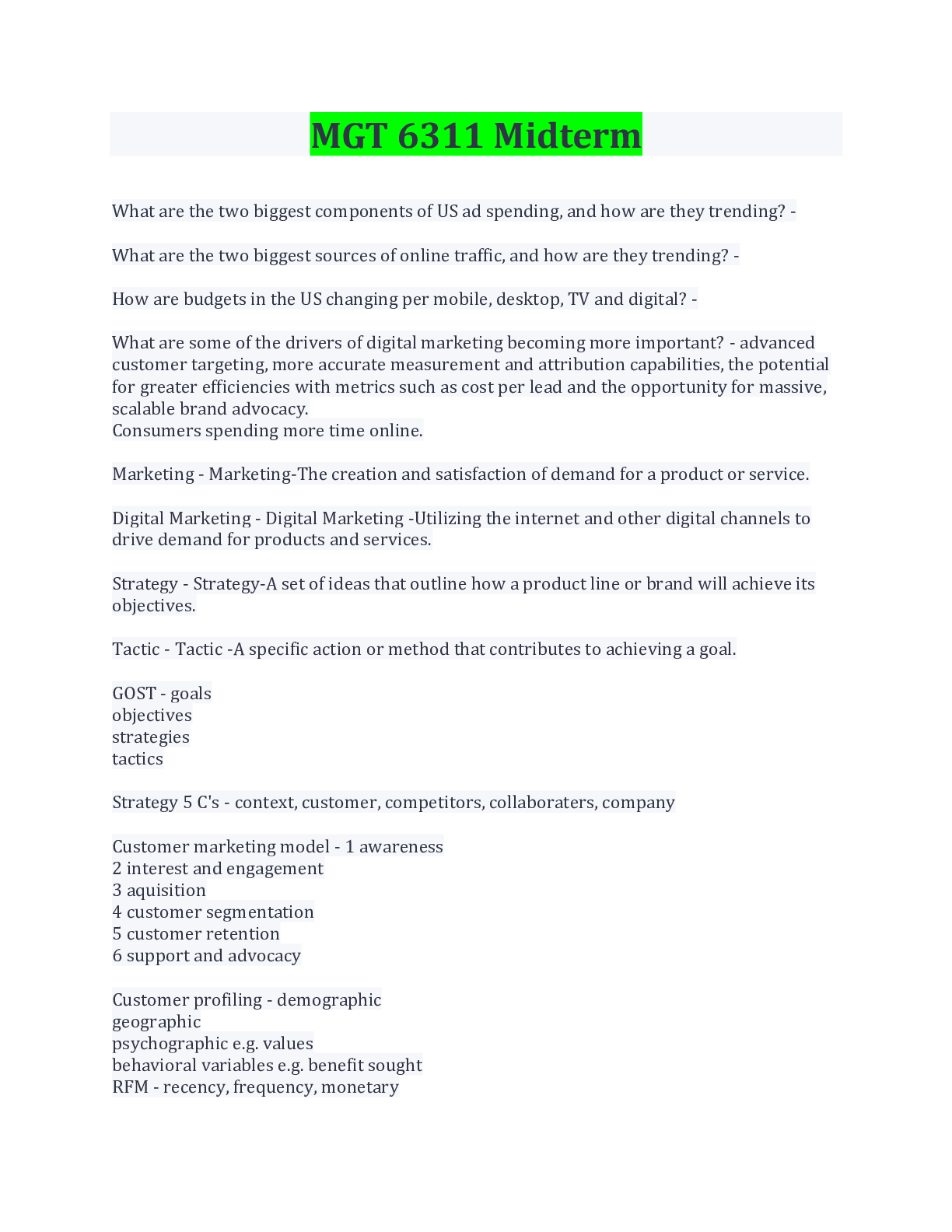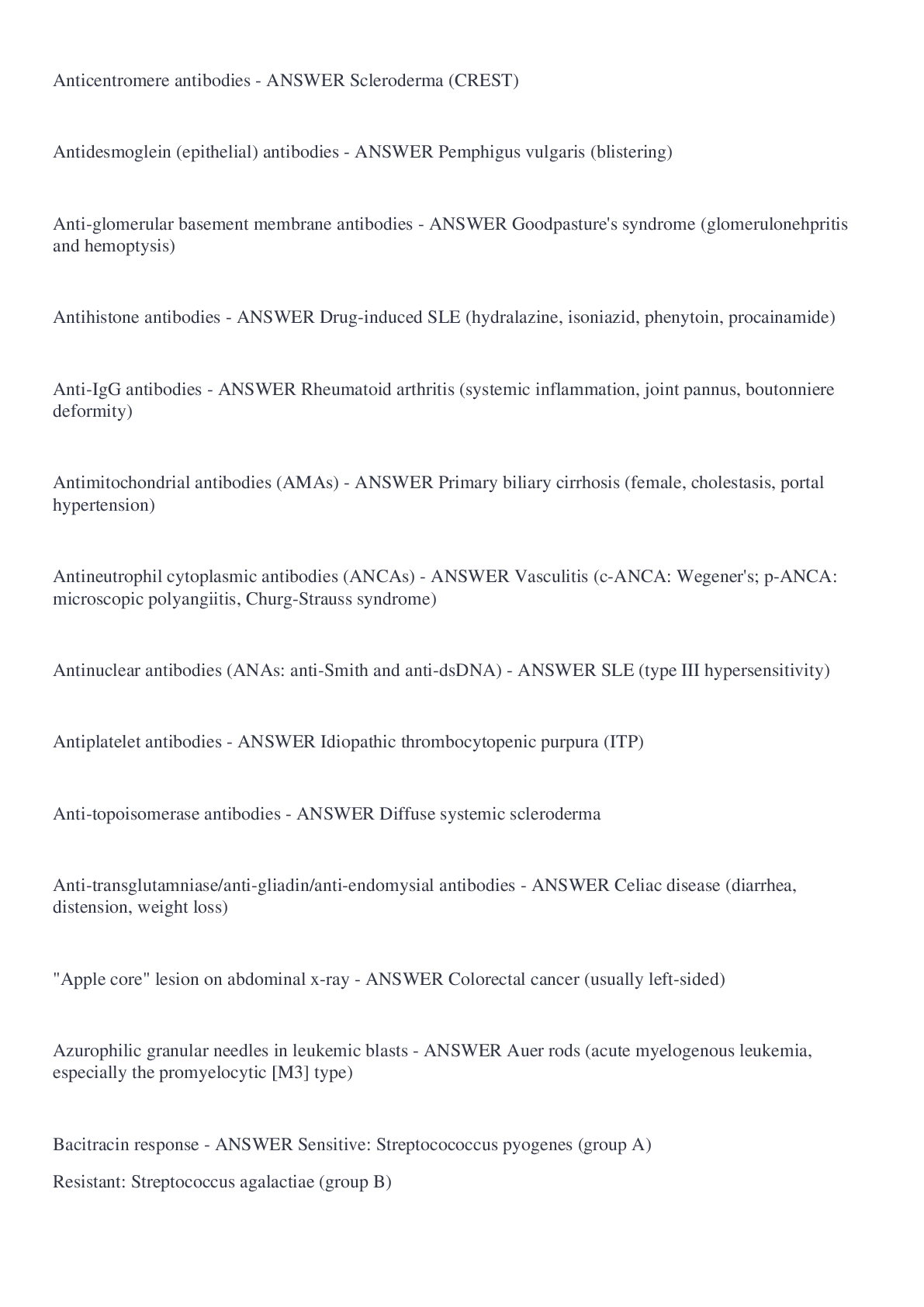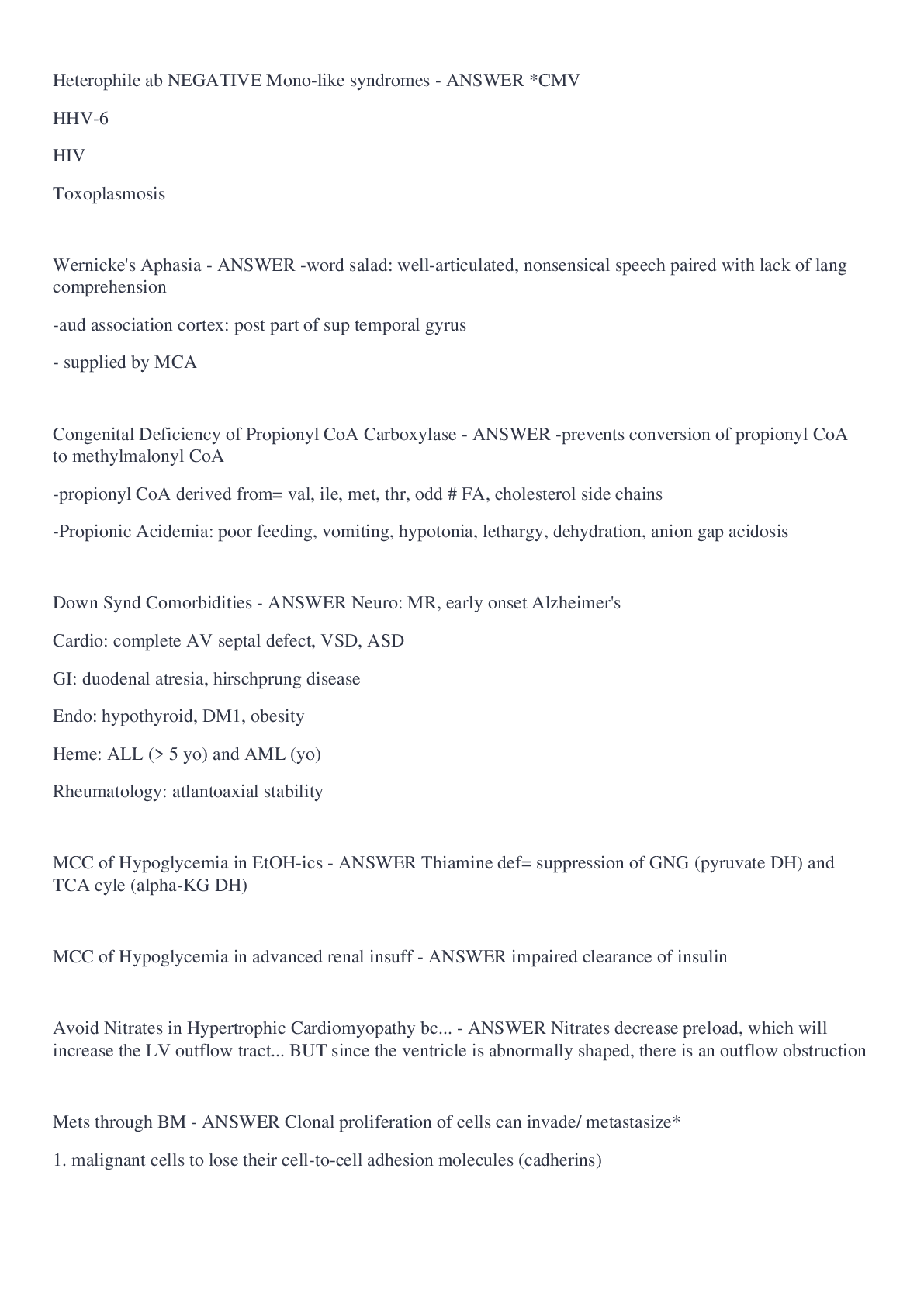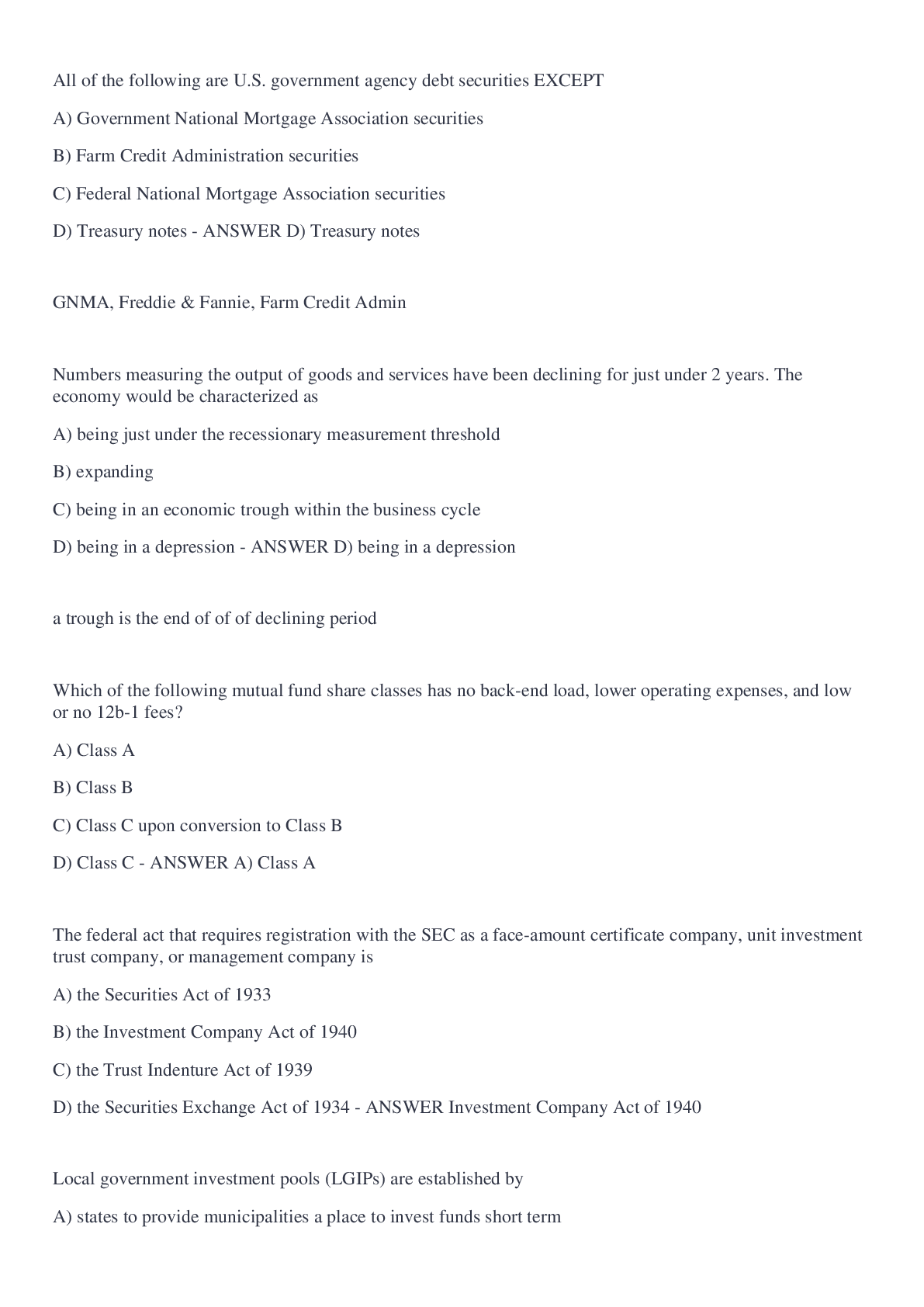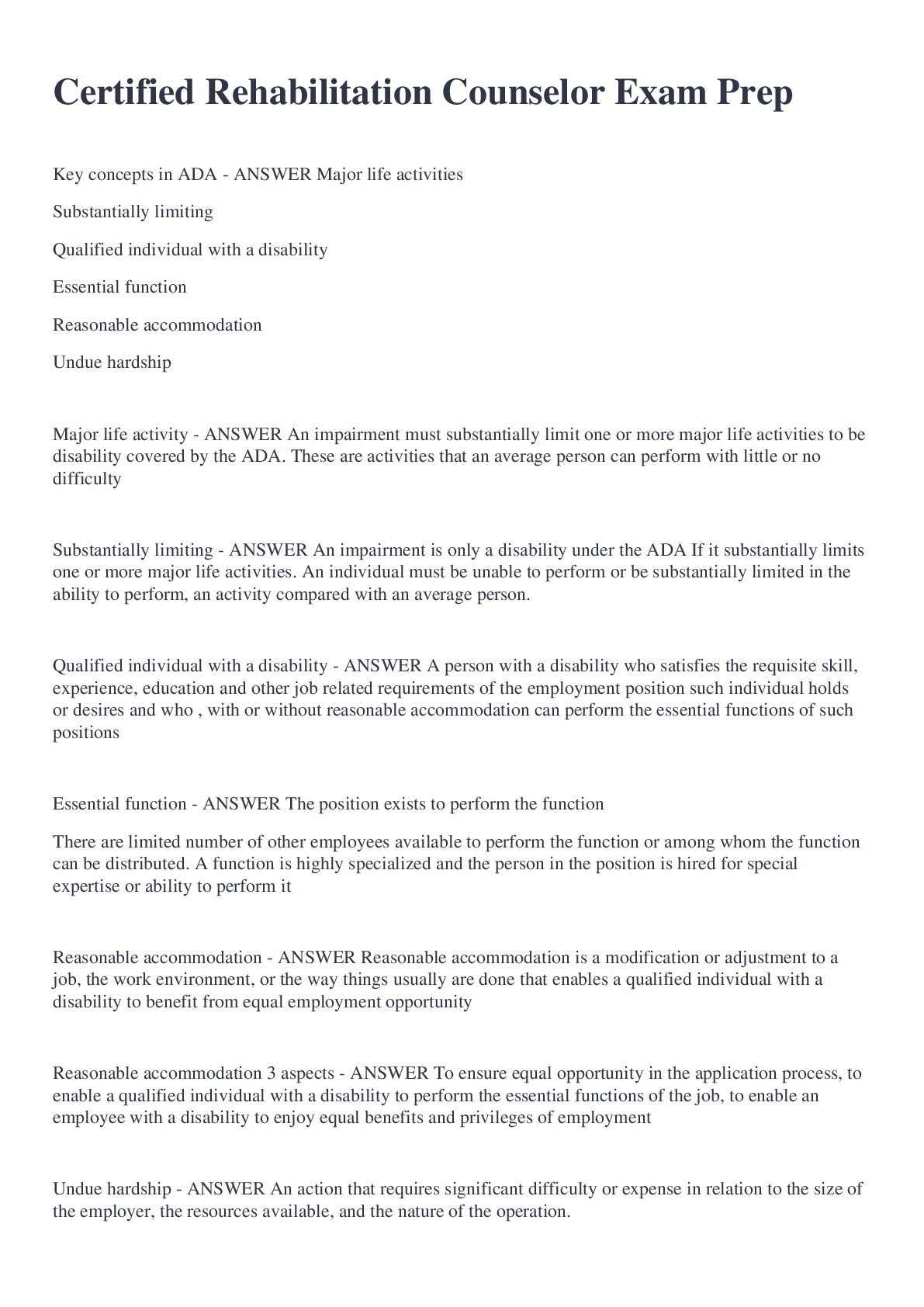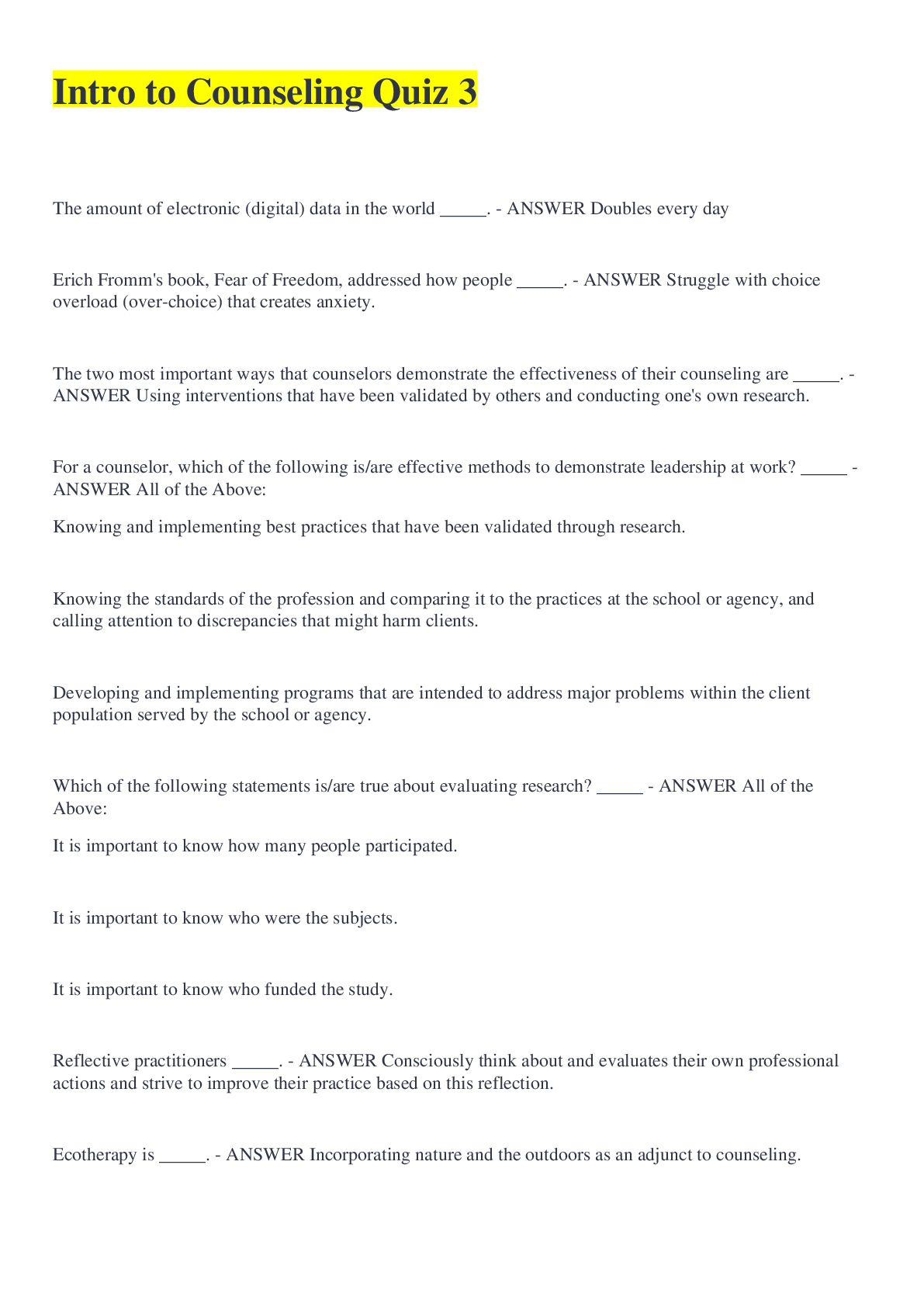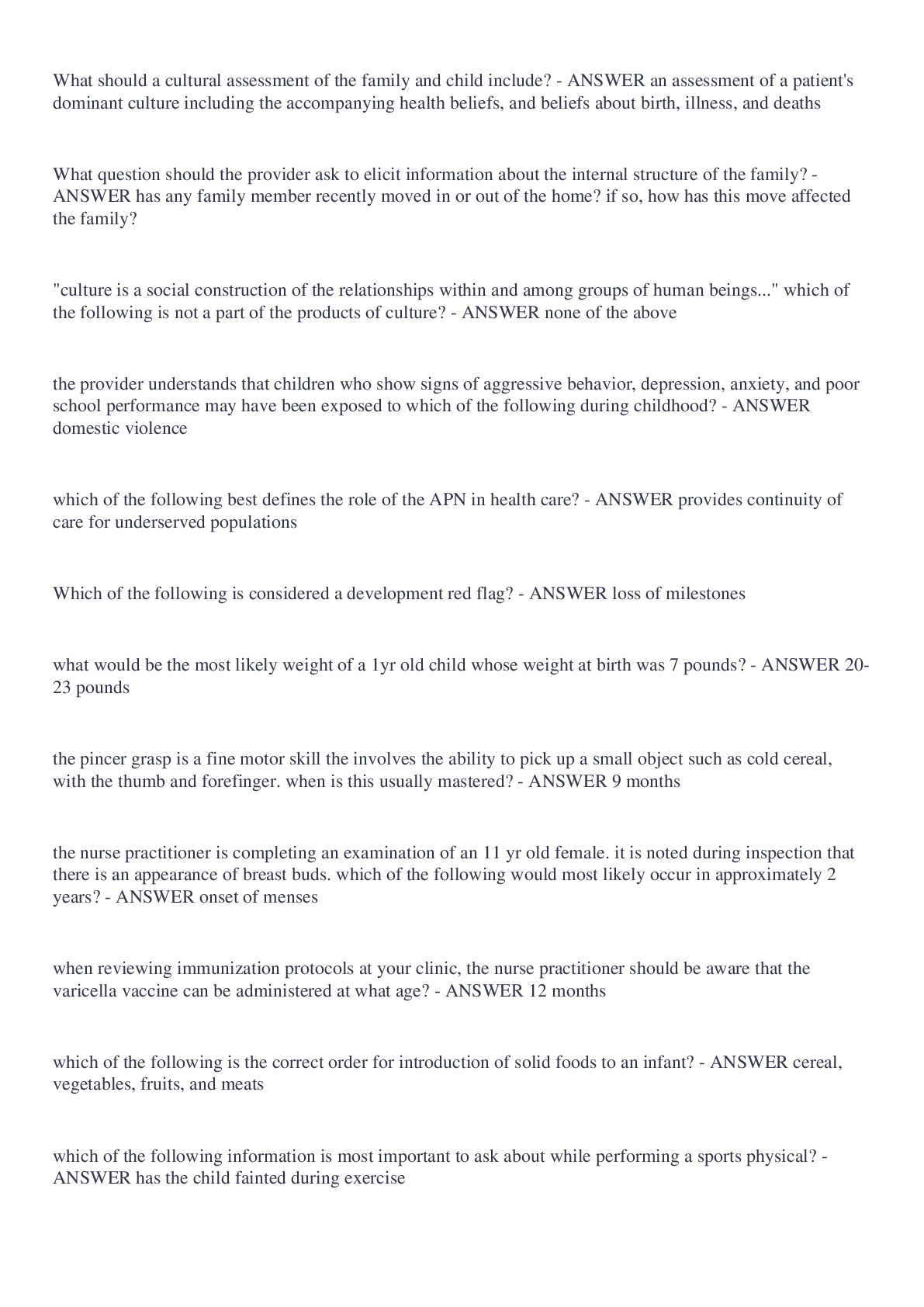*NURSING > EXAM > NURSING 2230 Mental Health Quiz 3 with complete solution.All answers are correct.Latest update,real (All)
NURSING 2230 Mental Health Quiz 3 with complete solution.All answers are correct.Latest update,real quiz.
Document Content and Description Below
Mental Health Quiz 3 Chapters 12, 13, 14, 15, 20 Chapter 12 Milieu Therapy - The Therapeutic Community 1. An angry client on an inpatient unit approaches a nurse, stating, Someone took my lunch... ! People need to respect others, and you need to do something about this now! The nurses response should be guided by which basic assumption of milieu therapy? A. Conflict should be avoided at all costs on inpatient psychiatric units. B. Conflict should be resolved by the nursing staff. C. Every interaction is an opportunity for therapeutic intervention. D. Conflict resolution should be addressed only during group therapy. 2. A client on an inpatient unit angrily states to a nurse, Peter is not cleaning up after himself in the community bathroom. You need to address this problem. Which is the appropriate nursing response? A. Ill talk to Peter and present your concerns. B. Why are you overreacting to this issue? C. You should bring this to the attention of your treatment team. D. I can see that you are angry. Lets discuss ways to approach Peter with your concerns. 3. A newly admitted client asks, Why do we need a unit schedule? Im not going to these groups. Im here to get some rest. Which is the most appropriate nursing reply? A. Group therapy provides the opportunity to learn and practice new coping skills. B. Group therapy is mandatory. All clients must attend. C. Group therapy is optional. You can go if you find the topic helpful and interesting. D. Group therapy is an economical way of providing therapy to many clients concurrently. 4. A client diagnosed with schizophrenia functions well and is bright, spontaneous, and interactive during hospitalization but then decompensates after discharge. What does the milieu provide that may be missing in the home environment? A. Peer pressure B. Structured programming C. Visitor restrictions D. Mandated activities 5. To promote self-reliance, how should a psychiatric nurse best conduct medication administration? A. Encourage clients to request their medications at the appropriate times. B. Refuse to administer medications unless clients request them at the appropriate times. C. Allow the clients to determine appropriate medication times. D. Take medications to the clients bedside at the appropriate times. 6. A nurse working on an inpatient psychiatric unit is assigned to conduct a 45-minute education group. What should the nurse identify as an appropriate group topic? A. Dream analysis B. Creative cooking C. Paint by number D. Stress management 7. What is the best rationale for including the clients family in therapy within the inpatient milieu? A. To structure a program of social and work-related activities B. To facilitate discharge from the hospital C. To provide a concrete demonstration of caring D. To encourage the family to model positive behaviors 8. How does a democratic form of self-government in the milieu contribute to client therapy? A. By setting punishments for clients who violate the community rules B. By dealing with inappropriate behaviors as they occur C. By setting community expectations wherein all clients are treated on an equal basis D. By interacting with professional staff members to learn about therapeutic interventions 9. A client has undergone psychological testing. With which member of the interdisciplinary team should a nurse collaborate to review these results? A. The psychiatrist B. The psychiatric social worker C. The clinical psychologist D. The clinical nurse specialist 10. In the role of milieu manager, which activity should the nurse prioritize? A. Setting the schedule for the daily unit activities B. Evaluating clients for medication effectiveness C. Conducting therapeutic group sessions D. Searching newly admitted clients for hazardous objects 11. A nurse attends an interdisciplinary team meeting on an inpatient unit. Which of the following individuals are typically included as members of the interdisciplinary treatment team in psychiatry? Select all that apply. A. Respiratory therapist B. Occupational therapist C. Recreational therapist D. Social worker E. Mental health technician 12. Which of the following are accurate descriptors of a therapeutic community? Select all that apply. A. The unit schedule includes unlimited free time for personal reflection. B. Unit responsibilities are assigned according to client capabilities. C. A flexible schedule is determined by client needs. D. The individual is the sole focus of therapy. E. A democratic form of government exists. Chapter 13 Crisis Intervention 1. A mother is concerned about her ability to perform in her new role. She is quite anxious and refuses to leave the postpartum unit. To offer effective client care, a nurse should recognize which information about this type of crisis? A. This type of crisis is precipitated by unexpected external stressors. B. This type of crisis is precipitated by preexisting psychopathology. C. This type of crisis is precipitated by an acute response to an external situational stressor. D. This type of crisis is precipitated by normal life-cycle transitions that overwhelm the client. 2. A wife brings her husband to an emergency department after an attempt to hang himself. He is a full-time student and works 8 hours at night to support his family. He states, I cant function any longer under all this stress. Which type of crisis is the client experiencing? A. Maturational/developmental crisis B. Psychiatric emergency crisis C. Anticipated life transition crisis D. Traumatic stress crisis 3. A client comes to a psychiatric clinic, experiencing sudden extreme fatigue and decreased sleep and appetite. The client works 12 hours a day and rates anxiety as 8/10 on a numeric scale. What correctly written long-term outcome is realistic in addressing this clients crisis? A. The client will change his or her type A personality traits to more adaptive ones by week 1. B. The client will list five positive self-attributes. C. The client will examine how childhood events led to an overachieving orientation. D. The client will return to previous adaptive levels of functioning by week 6. 4. A high school student has learned that she cannot graduate. Her boyfriend will be attending a college out of state that she planned to also attend. She is admitted to a psychiatric unit after overdosing on Tylenol. Which is the correctly written priority nursing diagnosis for this client? A. Ineffective coping R/T situational crisis AEB powerlessness B. Anxiety R/T fear of failure C. Risk for self-directed violence R/T hopelessness D. Risk for low self-esteem R/T loss events AEB suicidal ideations 5. After threatening to jump off a bridge, a client is brought to an emergency department by police. To assess for suicide potential, which question should a nurse ask first? A. Are you currently thinking about harming yourself? B. Why do you want to harm yourself? C. Have you thought about the consequences of your actions? D. Who is your emergency contact person? 6. An involuntarily committed client, when offered a dinner tray, pushes it off the bedside table onto the floor. Which intervention should a nurse prioritize to address this behavior? A. Initiate forced medication protocol. B. Help the client to explore the source of anger. C. Ignore the act to avoid reinforcing the behavior. D. With staff support and a show of solidarity, set firm limits on the behavior. 7. A college student who was nearly raped while jogging completes a series of appointments with a rape crisis nurse. At the final session, which client statement most clearly suggests that the goals of crisis intervention have been met? A. Youve really been helpful. Can I count on you for continued support? B. I dont work out anymore. C. Im really glad I didnt go home. It would have been hard to come back. D. I carry mace when I jog. It makes me feel safe and secure. 8. A despondent client, who has recently lost her husband of 30 years, tearfully states, Ill feel a lot better if I sell my house and move away. Which nursing reply is most appropriate? A. Im confident you know whats best for you. B. This may not be the best time for you to make such an important decision. C. Your children will be terribly disappointed. D. Tell me why you want to make this change. 9. An inpatient client with a known history of violence suddenly begins to pace. Which client behavior should alert a nurse to escalating anger and aggression? A. The client requests prn medications. B. The client has a tense facial expression and body language. C. The client refuses to eat lunch. D. The client sits in group therapy with back to peers. 10. What is the best nursing rationale for holding a debriefing session with clients and staff after clients have witnessed a peer being taken down after a violent outburst? A. To reinforce unit rules with the client population B. To create protocols for the future release of tensions associated with anger C. To process feelings and concerns related to the witnessed intervention D. To discuss the client problems that led to inappropriate expressions of anger 11. Which of the following nursing statements and/or questions represent appropriate communication to assess an individual in crisis? Select all that apply. A. Tell me what happened. B. What coping methods have you used, and did they work? C. Describe to me what your life was like before this happened. D. Lets focus on the current problem. E. Ill assist you in selecting functional coping strategies. 12. Which of the following are effective interventions that a nurse should utilize when caring for an inpatient client who expresses anger inappropriately? Select all that apply. A. Maintain a calm demeanor. B. Clearly delineate the consequences of the behavior. C. Use therapeutic touch to convey empathy. D. Set limits on the behavior. E. Teach the client to avoid I statements related to expression of feelings. Chapter 14 Assertiveness Training 1. During a psychoeducational group on assertiveness training, a client asks, Why do we need to learn about this stuff? Which is the most appropriate nursing reply? A. Because your doctor requires you to attend this group. B. Being assertive is the ability to stand up for yourself while respecting the rights of others. C. Assertiveness training teaches you how to ask for what you want, when you want it. D. Assertive people place the needs and rights of others before their own. 2. Two clients are roommates on an inpatient psychiatric unit. At breakfast, client A, who had been missing her gold locket, notices client B wearing it. Which should a nurse recognize as a nonassertive or passive behavioral response from client A? A. Client A ignores the situation. B. Client A discusses the situation with her nurse and develops a plan of action. C. Client A immediately approaches client B and pulls the necklace off her neck. D. Client A offers to wash client Bs clothes and accidentally spills bleach in the water. 3. A client on an inpatient unit is angry with a peer. During lunch, when the peer is not looking, the client spits into his soup. How would the nurse document this interaction? A. Client is displaying assertive behaviors. B. Client is displaying aggressive behaviors. C. Client is displaying passive behaviors. D. Client is displaying passiveaggressive behaviors. 4. A client continually waits more than an hour before being seen at the mental health clinic. The client approaches the nurse and states, When I have to wait for more than an hour to be seen, I feel like my time is not important. The nurse recognizes this as what type of behavior? A. Aggressive behavior B. Assertive behavior C. Passiveaggressive behavior D. Passive behavior 5. During an assertiveness training group, a client admits to aggressive behaviors. The client asks for suggestions for how to become more assertive and less aggressive. Which is the most appropriate nursing reply? A. Several techniques, including meditation and progressive muscle relaxation, appear helpful. B. Theres not much that can be done about aggressive behavior because of biological responses. C. Certain types of medications have been proven effective in promoting assertive communication. D. There are several techniques, including I statements, role playing, and thought stopping, that can help promote assertive behaviors and decrease aggressive behaviors. 6. During an assertiveness training group, a nurse suggests using I statements. The group questions the usefulness of this communication technique. Which explanation by the nurse is most appropriate? A. When I statements are used, opinions are communicated without blaming others. B. When I statements are used, anger is displaced by using indirect means. C. When I statements are used, responsibility for ones behavior is attributed to another. D. When I statements are used, eye contact is promoted. 7. While trying to control aggressive behavior, a client asks an assertiveness training nurse to give an example of an I statement. Which of the following statements is the best example of this assertive communication technique? A. I would like to know why you came home late without calling me. B. I hate it when you think you can just come home late without calling anyone to let them know where you are. C. I feel angry when you come home late without calling. D. I think you dont care about me, because if you did, youd call me if you were planning on coming home late. 8. After vying for a nurse management position, nurse A is chosen over nurse B. When nurse manager A calls for staff meetings, nurse B is chronically late or absent. Nurse B is exhibiting which type of behavior? A. Passive B. Assertive C. Aggressive D. Passiveaggressive 9. A nurse should assign which nursing diagnosis to a client needing assistance with assertiveness? A. Disturbed personal identity B. Disturbed thought processes C. Defensive coping D. Impaired verbal communication 10. Two clients get into a heated argument regarding TV program selections. The nurse turns off the TV and asks the clients to go to their rooms to cool off, after which they will discuss and attempt to resolve the problem. The nurses action is promoting which assertive technique? A. Defusing B. Clouding or fogging C. Responding as a broken record D. Shifting from content to process 11. An emergency department nurse, who has worked 10 straight days, is pulled to the psychiatric unit. Which represents a passiveaggressive statement by the emergency department nurse? A. Get someone else to work 3 to 11! Ive been working 10 days straight, and I need a break! B. Okay. Ill do it, then purposefully leaves paperwork undone when leaving the unit at 11 p.m. C. I have worked 10 days straight, and I cannot work tonight. I will work for you tomorrow if you need me. D. Yes, Ill do it. Anything to keep peace with the hospital administration is a good thing. 12. Which best describes a nurses use of assertive behavior? A. When a nurse attempts to please others and apologizes for awkwardness in a new role B. When a nurse becomes defensive and angry when peers offer suggestions for improvement C. When a nurse has problems making decisions and has a tendency to procrastinate D. When a nurse is open and direct when asked by the nurse manager to complete assignments 13. Which is the most appropriate nursing reply when a client asks what the goal and benefit are of assertive skills training? A. It protects the client from others who express aggressive feelings. B. It gives reliable, expert information so that clients may correct faulty behaviors. C. It clarifies misperceptions that have caused clients to distort reality. D. It improves communication skills in order to improve interpersonal relationships. 14. An instructor is teaching about assertive rights. Which student statement indicates a need for further instruction? A. The right to be treated with respect is an assertive right. B. The right to say no without feeling guilty is an assertive right. C. The right to change your mind is an assertive right. D. The right to always put oneself first is an assertive right. 15. One nurse confronts another and says, You are always so talkative in the meetings. I dont know why you cant stay quiet sometimes. Which reply by the other nurse reflects the technique of clouding/fogging? A. Youre right. I do speak up a lot. B. Sounds to me like youre agitated and we need to talk. What are you truly angry about? C. Are you offended that I speak up, or because my thoughts are in opposition to yours? D. I have the right to express my opinion. 16. A teenager gets a C in algebra. The mother angrily states, All you ever do is listen to music and text your friends. The teenager replies, What is it that youre really upset about, mom? Which response pattern is the teenager expressing? A. Clouding and fogging B. Shifting from content to process C. Delaying assertively D. Assuming responsibility for ones own statements 17. The dean of nursing criticizes a faculty member about views on academic freedom. The faculty member states, Are you upset because I believe in academic freedom or because you dont? The faculty member is using which technique to promote assertive behavior? A. Standing up for ones basic human rights B. Delaying assertively C. Inquiring assertively D. Responding assertively with irony 18. An aggressive nurse manager tells a staff nurse she has no business rallying staff to change the schedule. What would be an example of a technique that the staff nurse could use to stand up for her basic human rights? A. What is the real reason that you dont want the schedule changed? B. Sounds to me like youre threatened by this change. C. Are you upset because you dont want to redo the schedule? D. I have the right to express my opinion about the schedule. 19. A nursing supervisor is scheduling holiday hours. When the supervisor tells the staff nurse that she needs to work Christmas day, the staff nurse calmly states, I worked last Christmas and will not work this Christmas. When the supervisor says But I need you to work, the nurse repeats I worked last Christmas and will not work this Christmas. This is an example of which assertive behavior technique? A. Shifting from content to process B. Standing up for ones basic rights C. Responding as a broken record D. Defusing 20. A nurse has identified the following nursing diagnosis: ineffective communication R/T lack of assertiveness skills AEB inability to state needs. Which statement encourages the client to acknowledge the priority of this problem? A. Are you having thoughts of harming yourself or others? B. With whom are you least assertive? C. On a scale of 1 to 10, rank the importance of being assertive. D. When are you available to attend the assertiveness training class? 21. Which of the following are behavioral components of assertive communication? A. Listening B. You statements C. Closed posture D. Continuous direct eye contact 22. A client is experiencing high stress. The client states, My boss treats me like a doormat and thinks nothing of demanding frequent overtime. Which nursing intervention would be appropriate? A. To incorporate the family support system into the clients plan of care B. To teach thought-reframing techniques C. To encourage the client to seek other employment D. To teach the client how to use I statements 23. A nurse is caring for four clients. Which of the following clients should the nurse identify as likely to experience difficulty in being assertive? Select all that apply. A. A 20-year-old woman who is completing college homework assignments for several peers. B. A 69-year-old widow who is socially isolated C. A 17-year-old boy with conduct disorder D. A 45-year-old successful executive E. A 50-year-old diagnosed with narcissistic personality disorder Chapter 15 Promoting Self-Esteem 1. A nurse is working in a nursing home. How best can this nurse foster self-esteem in the residents of this facility? A. Allowing them to remain in their rooms as much as they desire to maintain privacy B. Administering anti-anxiety medications as ordered C. Providing a sense of mastery over their environment by giving choices when appropriate D. Teaching assertiveness skills and self-esteem principles 2. A client shows a nurse a piece of artwork that took 3 days to create. How will this achievement improve the clients self-esteem? A. By providing a framework for assertive behavior B. By providing an expression of feelings and a sense of competence and pride C. By providing a positive perception of body image D. By providing appropriate boundaries for relationship establishment 3. A nurse is running a group on self-esteem. A client asks, Where does self-esteem come from? Which is the most appropriate nursing reply? A. Many factors, over the life span, influence development and maintenance of self-esteem. B. Self-esteem is determined by factors outside of an individuals control. C. Self-esteem is established in childhood and remains relatively fixed throughout life. D. Genetics are the single largest contributor to an individuals self-esteem. Self-esteem refers to the degree of regard or respect that individuals have for themselves and is a measure of 4. In what way should a nurse expect a school-aged child to gain positive self-esteem, according to Eriksons psychosocial developmental stages? A. Through basic need fulfillment and environmental predictability B. Through exploration and experimentation, resulting in self-confidence in ability to perform C. Through positive reinforcement of creativity and recognition of performance D. Through receiving recognition when learning, competing, and performing successfully 5. The nurse is working with a 15-year-old client suffering from low self-esteem. According to Eriksons psychosocial developmental theory, which factor has most probably influenced this clients self-esteem? A. Regret over life choices B. Lack of personal concern for others C. Inconsistent, overly harsh, or absent parental discipline D. Parental labeling of the child as good regardless of their behavior. 6. On the basis of Eriksons theory, how should a nurse encourage a 40-year-old client to improve his or her self-esteem? A. Encourage the client to review life goals and accomplishments. B. Encourage the client to volunteer at a school, reading to underprivileged children. C. Encourage the client to form lasting intimate relationships. D. Encourage the client to seek recognition for task achievement. 7. Which is an appropriate initial nursing intervention for a client with chronic low self-esteem? A. Assessing the content of negative self-talk B. Administering anxiolytic medications C. Using reassurance and physical touch D. Using distraction techniques 8. A 30-year-old client diagnosed with depression has been exclusively cared for and financially subsidized by his mother since age 17. According to Eriksons theory, the nurse recognizes that the client has been unsuccessful in meeting which developmental task? A. Trust B. Initiative C. Intimacy D. Ego integrity 9. A 40-year-old female client has never experienced an intimate relationship. A nursing student tells an instructor that this client remains in Eriksons developmental stage of intimacy versus isolation. What is the instructors most appropriate reply? A. Eriksons stages of development are assessed by chronological age, not task achievement. This client is in the generativity versus stagnation stage, which occurs from 30 to 65 years of age. B. Eriksons stages of development are assessed by task achievement, not chronological age. This client is in the intimacy versus isolation stage, which occurs from 20 to 30 years of age. C. Eriksons stages of development are assessed by task achievement, not chronological age. This client is in the generativity versus stagnation stage, which occurs from 30 to 65 years of age. D. Eriksons stages of development are assessed by chronological age, not task achievement. 10. A home health nurse visits an 18-year-old client who lives with his mother. The client has been assessed as having low self-esteem. The nurse refers the client for individual counseling. During the next home visit, which assessed client behavior clearly indicates treatment success? A. The client wants to buy a dog but has not yet asked his mothers permission. B. The client asks his mother for permission to buy a dog. C. The client tells his mother he plans to buy a dog. D. The client buys a dog and hides it in the garage. 11. A 40-year-old client lives with her parents. She has a high school diploma and works at a low-paying job. Her parents give her a weekly allowance to supplement her income. How should the nurse classify their client- parent boundaries? A. As loose B. As rigid C. As flexible D. As enmeshed 12. A father tells his 5-year-old, Son, today instead of picking flowers in the outfield, lets try to catch a ball. The child subsequently pays attention and catches a ball. Which principle of building self-esteem has the father implemented? A. A sense of competence B. Unconditional love C. Realistic goals D. Reality orientation 13. A nursing instructor is teaching about self-concept. Which student statement indicates a need for further instruction? A. Self-concept is the thinking component of the self. B. Self-concept is a system of learned beliefs about self. C. Self-concept is the degree of regard that individuals have for themselves. D. Self-concept is the attitudes and opinions held true about personal existence. 14. A client has continual problematic relationships and rejects others before possibly being rejected. The client states, I am afraid of failing in my job responsibilities. Which correctly written nursing diagnosis should be prioritized for this client? A. Poor self-esteem R/T negative self-image AEB fear of failure B. Altered thought processes R/T anxiety AEB delusions C. Role confusion R/T rejection and poor job productivity D. High risk for violence: self-directed R/T rejection of others 15. A nurse is caring for a client who has recently undergone a radical prostatectomy. Which of the following should the nurse recognize as objective symptoms of low self-esteem? Select all that apply. A. Withdrawal from activities B. A decrease in self-care behaviors C. Poor eye contact D. Reports of pain E. Poor posture 16. A 47-year-old mother of two has recently undergone a radical mastectomy. She refuses to see anyone and remains isolated and withdrawn. Which of the following may be relevant nursing diagnoses for this client? Select all that apply. A. Disturbed body image B. Situational low self-esteem C. Ineffective coping D. Altered thought processes E. Altered sensory perception Chapter 20 Electroconvulsive Therapy 1. A nurse administers pure oxygen to a client during and after electroconvulsive therapy. What is the nurses rationale for this procedure? A. To prevent increased intracranial pressure resulting from anoxia B. To prevent hypotension, bradycardia, and bradypnea due to electrical stimulation C. To prevent anoxia due to medication-induced paralysis of respiratory muscles D. To prevent blocked airway resulting from seizure activity 2. Immediately after electroconvulsive therapy, in which position should a nurse place the client? A. On his or her side to prevent aspiration B. In semi-Fowlers position to promote oxygenation C. In Trendelenburgs position to promote blood flow to vital organs D. In prone position to prevent airway blockage 3. A nursing instructor is teaching about electroconvulsive therapy (ECT). Which student statement indicates that learning has occurred? A. During ECT a state of euphoria is induced. B. ECT induces a grand mal seizure. C. During ECT a state of catatonia is induced. D. ECT induces a petit mal seizure. 4. A chronically depressed and suicidal client is admitted to a psychiatric unit. The client is scheduled for electroconvulsive therapy (ECT). During the course of ECT, a nurse should recognize the continued need for which critical intervention? A. Suicide assessment must continue throughout the ECT course. B. Antidepressant medications are contraindicated throughout the ECT course. C. Discourage expressions of hopelessness throughout the ECT course. D. Encourage a high-caloric diet throughout the ECT course. 5. After undergoing two of nine electroconvulsive therapy (ECT) procedures, a client states, I cant even remember eating breakfast, so I want to stop the ECT. Which is the most appropriate nursing reply? A. After you begin the course of treatments, you must complete all of them. B. Youll need to talk with your doctor about what youre thinking. C. It is within your right to discontinue the treatments, but lets talk about your concerns. D. Memory loss is a rare side effect of the treatment. I dont think it should be a concern. 6. Immediately after an initial electroconvulsive therapy (ECT) procedure, a client states, Im not hungry and just want to stay in bed and sleep. On the basis of this information, which is the most appropriate nursing intervention? A. Allow the client to remain in bed. B. Encourage the client to join the milieu to promote socialization. C. Obtain a physicians order for parenteral nutrition. D. Involve the client in physical activities to stimulate circulation. 7. A nurse administers ordered preoperative glycopyrrolate (Robinul) 30 minutes prior to a clients electroconvulsive therapy (ECT) procedure. What is the rationale for administering this medication? A. Robinul decreases anxiety during the ECT procedure. B. Robinul induces an unconscious state to prevent pain during the ECT procedure. C. Robinul prevents severe muscle contractions during the ECT procedure. D. Robinul decreases secretions to prevent aspiration during the ECT procedure. 8. A nursing instructor is teaching about the medications given prior to and during electroconvulsive therapy (ECT). Which student statement indicates that learning has occurred? A. Atropine (Atro-Pen) is administered to paralyze skeletal muscles during ECT. B. Succinylcholine chloride (Anectine) decreases secretions to prevent aspiration. C. Thiopental sodium (Pentothal) is a short-acting anesthesia to render the client unconscious. D. Glycopyrrolate (Robinul) is given to prevent severe muscle contractions during seizure. 9. A client scheduled for electroconvulsive therapy (ECT) at 9:00 a.m. is discovered eating breakfast at 8:00 a.m. On the basis of this observation, which is the most appropriate nursing action? A. The nurse notifies the clients physician of the situation and cancels the ECT. B. The nurse removes the breakfast tray and assists the client to the ECT procedure room. C. The nurse allows the client to finish breakfast and reschedules ECT for 10:00 a.m. D. The nurse increases the clients fluid intake to facilitate the digestive process. 10. A client who is learning about electroconvulsive therapy (ECT) asks a nurse, Isnt this treatment dangerous? Which is the most appropriate nursing reply? A. No, this treatment is side-effect free. B. There can be temporary paralysis, but full functioning returns within 3 hours of treatment. C. There are some risks, but a thorough examination will determine your candidacy for ECT. D. Transient ischemic attacks (TIAs) can occur but are rare. 11. A client experienced bradycardia during electroconvulsive therapy (ECT). A nurse assigns a nursing diagnosis of decreased cardiac output R/T vagal stimulation occurring during ECT. Which outcome would the nurse expect the client to achieve? A. The client will verbalize an understanding of the need for moving slowly after treatment. B. The client will maintain an oxygen saturation level of 88% 1 hour after treatment. C. The client will continue adequate tissue perfusion 1 hour after treatment. D. The client will verbalize an understanding of common side effects of ECT. 12. A nursing student is observing an electroconvulsive therapy (ECT) procedure. The student notices a blood pressure cuff on the clients lower leg. The student questions the instructor about the cuff placement. Which is the most accurate instructor reply? A. The cuff has to be placed on the leg because both arms are used for intravenous fluids. B. The cuff functions to prevent succinylcholine from reaching the foot. C. The cuff position gives a more accurate blood pressure reading during the treatment. D. The cuff is placed on the leg so that arms can easily be restrained during seizure. 13. A client states, My doctor has told me I am a candidate for electroconvulsive therapy (ECT). Where will the treatment take place, and how much time would this entail? Which is the most accurate nursing reply? A. Clients typically receive ECT in their hospital room, daily for 1 month. B. Clients typically undergo 6 to 12 ECT procedures, three times a week in an outpatient setting. C. Clients typically receive an unlimited number of treatments, in the hospital procedure room. D. Clients typically receive two to three treatments, in either an outpatient or inpatient setting. 14. A client is scheduled for an initial electroconvulsive therapy (ECT) procedure. Which information should a nurse include when teaching about the potential side effects of this procedure? A. You may experience transient tangential thinking. B. You may experience some memory deficit surrounding the ECT. C. You may experience avolution for the remainder of the day. D. You may experience a higher risk for subsequent seizures. 15. When scheduling electroconvulsive therapy (ECT), which client should the nurse prioritize? A. A client in bed in a fetal position who is experiencing active suicidal ideations B. A client with an irritable mood and exhibiting angry outbursts C. A client experiencing command hallucinations and delusions of reference D. A client experiencing manic episodes of bipolar disorder 16. A client with cognitive deficits is extremely suicidal. The client has not responded to antidepressants and the treatment team is considering electroconvulsive therapy (ECT). What client information would impact the feasibility of this treatment option? A. Because the client is extremely suicidal, ECT is an appropriate option. B. Because antidepressant medications have been ineffective, ECT is a good alternative. C. Because informed consent is required for ECT, cognitive deficits could preclude this option. D. Because of the clients cognitive deficits, a signed consent is waived. A client who is experiencing cognitive deficits cannot give informed consent, which is required prior to ECT. A 17. A nurse should recognize that electroconvulsive therapy (ECT) would potentially improve the symptoms of clients with which of the following diagnoses? Select all that apply. A. Major depressive disorder B. Bipolar I disorder: manic episode C. Schizoaffective disorder D. Obsessive-compulsive disorder E. Body dysmorphic disorder 18. Which assessment results should a nurse evaluate and report in the process of clearing a client for electroconvulsive therapy (ECT)? Select all that apply. A. Electrocardiographic records B. Pulmonary function study results C. Electroencephalogram analysis D. Complete blood count values E. Urinalysis results 19. During a course of 12 electroconvulsive therapy (ECT) procedures, an anxious client diagnosed with major depression refuses to bathe or attend group therapy. He reports some memory problems and says he has trouble figuring out what time of day it is. At this time, which of the following nursing diagnoses should be assigned to this client? Select all that apply. A. Anxiety R/T post-ECT confusion and memory loss B. Risk for injury R/T post-ECT confusion and memory loss C. Risk for activity intolerance R/T post-ECT confusion and memory loss D. Altered sensory perception R/T post-ECT confusion and memory loss E. Social isolation R/T post-ECT confusion and memory loss 20. Which of the following conditions would place a client at risk for injury during electroconvulsive therapy (ECT)? Select all that apply. A. Severe osteoporosis B. Acute and chronic pulmonary disorders C. Hypothyroidism D. Recent cardiovascular accident E. Prostatic hypertrophy Quiz # 3 ATI Back Of Book CHAPTER 29 Crisis Management 1. A nurse is conducting chart reviews of multiple clients at a community mental health facility. Which of the following events is an example of client experiencing a maturational crisis? A. Rape B. Marriage C. Severe physical illness D. Job loss 2. A nurse is caring for a client who is experiencing a crisis. Which of the following medications might the provider prescribe? (Select all that apply.) A. Lithium carbonate B. Paroxetine C. Risperidone D. Haloperidol E. Lorazepam [Show More]
Last updated: 1 year ago
Preview 1 out of 17 pages

Reviews( 0 )
Document information
Connected school, study & course
About the document
Uploaded On
Jan 07, 2021
Number of pages
17
Written in
Additional information
This document has been written for:
Uploaded
Jan 07, 2021
Downloads
0
Views
28


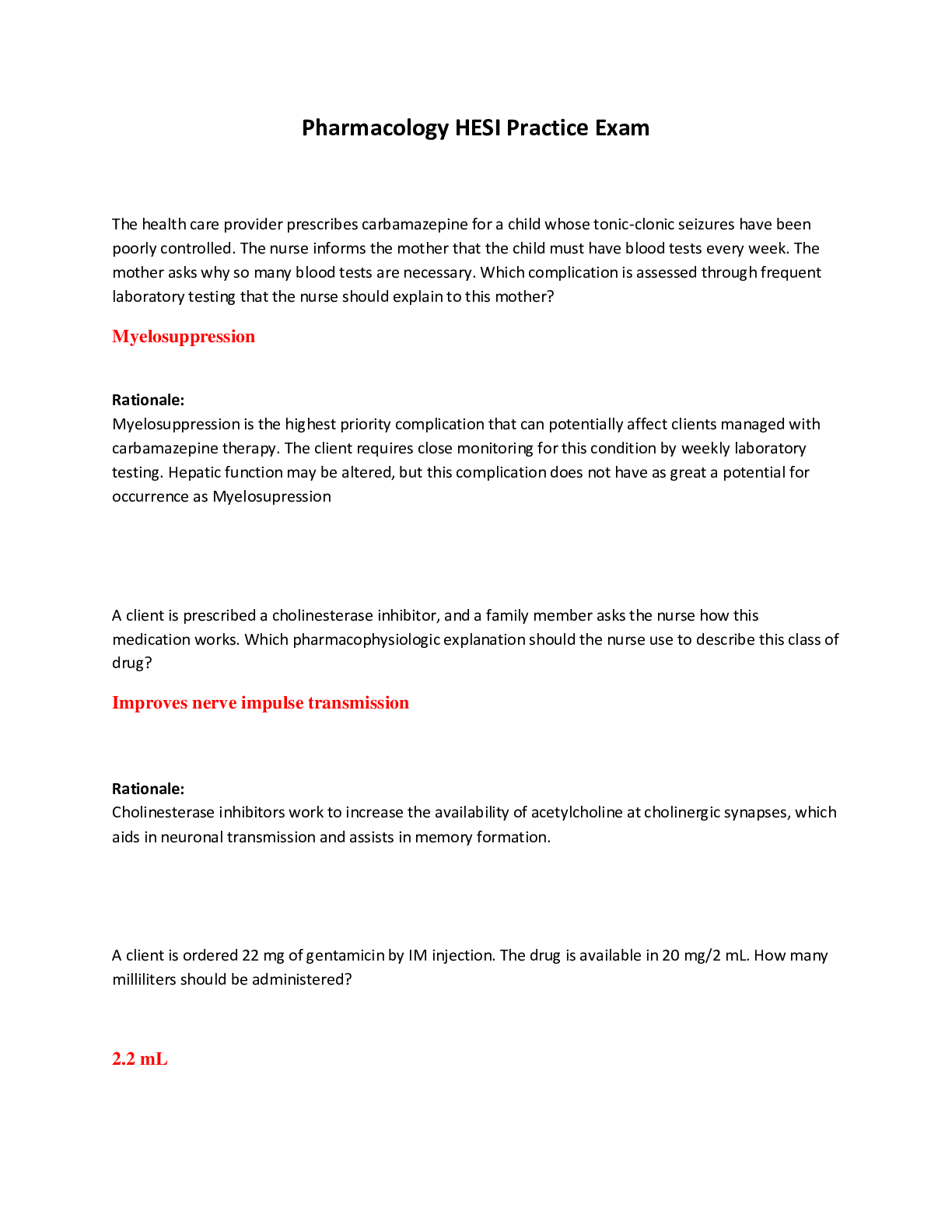
.png)
